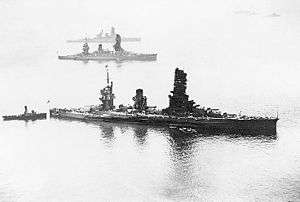Pacific War
| Pacific War | |||||||||
|---|---|---|---|---|---|---|---|---|---|
| Part of World War II | |||||||||
 Map showing the main areas of the conflict and Allied landings in the Pacific, 1942–45 | |||||||||
| |||||||||
| Belligerents | |||||||||
|
| and others [lower-alpha 3] | ||||||||
| Commanders and leaders | |||||||||
| |||||||||
| Strength | |||||||||
|
|
| ||||||||
| Casualties and losses | |||||||||
|
| ||||||||
| |||||||||
| History of Japan |
|---|
.svg.png) |
The Pacific War, sometimes called the Asia–Pacific War,[35] was the theater of World War II that was fought in the Pacific and Asia. It was fought over a vast area that included the Pacific Ocean and islands, the South West Pacific, South-East Asia, and in China (including the 1945 Soviet–Japanese conflict).
The Second Sino-Japanese War between the Empire of Japan and the Republic of China had been in progress since 7 July 1937, with hostilities dating back as far as 19 September 1931 with the Japanese invasion of Manchuria.[36] However, it is more widely accepted[lower-alpha 10][38] that the Pacific War itself began on 7/8 December 1941, when Japan invaded Thailand and attacked the British possessions of Malaya, Singapore, and Hong Kong as well as the United States military and naval bases in Hawaii, Wake Island, Guam and the Philippines.[39][40][41]
The Pacific War saw the Allies pitted against Japan, the latter briefly aided by Thailand and to a much lesser extent by the Axis allied Germany and Italy. The war culminated in the atomic bombings of Hiroshima and Nagasaki, and other large aerial bomb attacks by the Allies, accompanied by the Soviet declaration of war and invasion of Manchuria on 9 August 1945, resulting in the Japanese announcement of intent to surrender on 15 August 1945. The formal surrender of Japan ceremony took place aboard the battleship USS Missouri in Tokyo Bay on 2 September 1945. After the war, Japan lost all rights and titles to its former possessions in Asia and the Pacific, and its sovereignty was limited to the four main home islands.[42] Japan's Shinto Emperor was forced to relinquish much of his authority and his divine status through the Shinto Directive in order to pave the way for extensive cultural and political reforms.[43]
Overview
Names for the war
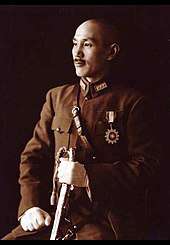
In Allied countries during the war, the "Pacific War" was not usually distinguished from World War II in general, or was known simply as the War against Japan. In the United States, the term Pacific Theater was widely used, although this was a misnomer in relation to the Allied campaign in Burma, the war in China and other activities within the Southeast Asian Theater.
Japan used the name Greater East Asia War (大東亜戦争 Dai Tō-A Sensō), as chosen by a cabinet decision on 10 December 1941, to refer to both the war with the Western Allies and the ongoing war in China. This name was released to the public on 12 December, with an explanation that it involved Asian nations achieving their independence from the Western powers through armed forces of the Greater East Asia Co-Prosperity Sphere.[44] Japanese officials integrated what they called the Japan–China Incident (日支事変 Nisshi Jihen) into the Greater East Asia War.
During the Allied military occupation of Japan (1945–52), these Japanese terms were prohibited in official documents, although their informal usage continued, and the war became officially known as the Pacific War (太平洋戦争 Taiheiyō Sensō). In Japan, the Fifteen Years' War (十五年戦争 Jūgonen Sensō) is also used, referring to the period from the Mukden Incident of 1931 through 1945.
Participants
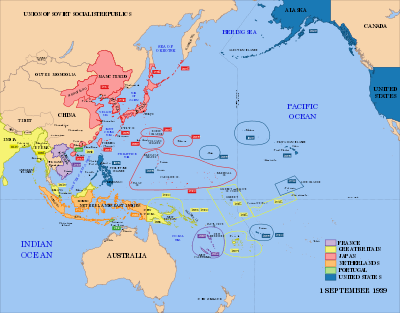
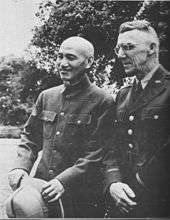
The Axis states which assisted Japan included the authoritarian government of Thailand, which quickly formed a temporary alliance with the Japanese in 1941, as the Japanese forces were already invading the peninsula of southern Thailand. The Phayap Army sent troops to invade and occupy northeastern Burma, which was former Thai territory that had been annexed by Britain much earlier. The official policy of the US government is that Thailand was not an ally of the Axis, and that the United States was not at war with Thailand. The policy of the US government ever since 1945 has been to treat Thailand not as a former enemy, but rather as a country which had been forced into certain actions by Japanese blackmail, before being occupied by Japanese troops. Thailand has been treated by the United States in the same way as such other Axis-occupied countries as Belgium, Czechoslovakia, Denmark, Greece, Norway, Poland, and the Netherlands.
Also involved were the Japanese puppet states of Manchukuo and Mengjiang (consisting of most of Manchuria and parts of Inner Mongolia respectively), and the collaborationist Wang Jingwei regime (which controlled the coastal regions of China). In preparation for the war against the United States, which would be decided at sea and in the air, Japan increased its naval budget as well as putting large formations of the Army and its attached air force under navy command. While formerly the IJA consumed the lion's share of the state's military budget due to the secondary role of the IJN in Japan's campaign against China (with a 73/27 split in 1940), from 1942 to 1945 there would instead be a roughly 60/40 split in funds between the army and the navy.[45]
Japan conscripted many soldiers from its colonies of Korea and Formosa (Taiwan). To a small extent, some Vichy French, Indian National Army, and Burmese National Army forces were active in the area of the Pacific War. Collaborationist units from Hong Kong (reformed ex-colonial police), the Philippines, Dutch East Indies (the PETA) and Dutch Guinea, British Malaya and British Borneo, Inner Mongolia and former French Indochina (after the overthrow of the Vichy French regime) as well as Timorese militia also assisted Japanese war efforts.
Germany and Italy both had limited involvement in the Pacific War. The German and the Italian navies operated submarines and raiding ships in the Indian and Pacific Oceans. The Italians had access to "concession territory" naval bases in China, while the Germans did not. After Japan's attack on Pearl Harbor and the subsequent declarations of war, both navies had access to Japanese naval facilities.
The major Allied participants were the United States, China, the United Kingdom (including the armed forces of British India, the Fiji Islands, Samoa, etc.), Australia, the Commonwealth of the Philippines, the Netherlands (as the possessor of the Dutch East Indies and the western part of New Guinea), New Zealand, and Canada, all of whom were members of the Pacific War Council.[46] Mexico, Free France and many other countries also took part, especially forces from other British colonies.
The Soviet Union fought two short, undeclared border conflicts with Japan in 1938 and 1939, then remained neutral until August 1945, when it joined the Allies and invaded the territory of Manchukuo, China, Inner Mongolia, the Japanese protectorate of Korea and Japanese-claimed territory such as South Sakhalin.
Theaters

Between 1942 and 1945, there were four main areas of conflict in the Pacific War: China, the Central Pacific, South-East Asia and the South West Pacific. US sources refer to two theaters within the Pacific War: the Pacific theater and the China Burma India Theater (CBI). However these were not operational commands.
In the Pacific, the Allies divided operational control of their forces between two supreme commands, known as Pacific Ocean Areas and Southwest Pacific Area.[47] In 1945, for a brief period just before the Japanese surrender, the Soviet Union and its Mongolian ally engaged Japanese forces in Manchuria and northeast China.
The Imperial Japanese Navy did not integrate its units into permanent theater commands. The Imperial Japanese Army, which had already created the Kwantung Army to oversee its occupation of Manchukuo and the China Expeditionary Army during the Second Sino-Japanese War, created the Southern Expeditionary Army Group at the outset of its conquests of South East Asia. This headquarters controlled the bulk of the Japanese Army formations which opposed the Western Allies in the Pacific and South East Asia.
Historical background
Conflict between China and Japan
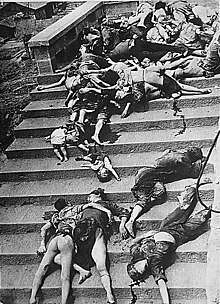
By 1937, Japan controlled Manchuria and was ready to move deeper into China. The Marco Polo Bridge Incident on 7 July 1937 provoked full-scale war between China and Japan. The Nationalist and Communist Chinese suspended their civil war to form a nominal alliance against Japan, and the Soviet Union quickly lent support by providing large amount of materiel to Chinese troops. In August 1937, Generalissimo Chiang Kai-shek deployed his best army to fight about 300,000 Japanese troops in Shanghai, but, after three months of fighting, Shanghai fell.[48] The Japanese continued to push the Chinese forces back, capturing the capital Nanking in December 1937 and conducted the Nanking Massacre.[49] In March 1938, Nationalist forces won their first victory at Taierzhuang,[50] but then the city of Xuzhou was taken by the Japanese in May. In June 1938, Japan deployed about 350,000 troops to invade Wuhan and captured it in October.[51] The Japanese achieved major military victories, but world opinion—in particular in the United States—condemned Japan, especially after the Panay incident.
In 1939, Japanese forces tried to push into the Soviet Far East from Manchuria. They were soundly defeated in the Battle of Khalkhin Gol by a mixed Soviet and Mongolian force led by Georgy Zhukov. This stopped Japanese expansion to the north, and Soviet aid to China ended as a result of the signing of the Soviet–Japanese Neutrality Pact at the beginning of its war against Germany.[52]
In September 1940, Japan decided to cut China's only land line to the outside world by seizing Indochina, which was controlled at the time by Vichy France. Japanese forces broke their agreement with the Vichy administration and fighting broke out, ending in a Japanese victory. On 27 September Japan signed a military alliance with Germany and Italy, becoming one of the three Axis Powers. In practice, there was little coordination between Japan and Germany until 1944, by which time the US was deciphering their secret diplomatic correspondence.[53]
The war entered a new phase with the unprecedented defeat of the Japanese at the Battle of Suixian–Zaoyang, 1st Battle of Changsha, Battle of Kunlun Pass and Battle of Zaoyi. After these victories, Chinese nationalist forces launched a large-scale counter-offensive in early 1940; however, due to its low military-industrial capacity, it was repulsed by the Imperial Japanese Army in late March 1940.[54] In August 1940, Chinese communists launched an offensive in Central China; in retaliation, Japan instituted the "Three Alls Policy" ("Kill all, Burn all, Loot all") in occupied areas to reduce human and material resources for the communists.[55]
By 1941 the conflict had become a stalemate. Although Japan had occupied much of northern, central, and coastal China, the Nationalist Government had retreated to the interior with a provisional capital set up at Chungking while the Chinese communists remained in control of base areas in Shaanxi. In addition, Japanese control of northern and central China was somewhat tenuous, in that Japan was usually able to control railroads and the major cities ("points and lines"), but did not have a major military or administrative presence in the vast Chinese countryside. The Japanese found its aggression against the retreating and regrouping Chinese army was stalled by the mountainous terrain in southwestern China while the Communists organised widespread guerrilla and saboteur activities in northern and eastern China behind the Japanese front line.
Japan sponsored several puppet governments, one of which was headed by Wang Jingwei.[56] However, its policies of brutality toward the Chinese population, of not yielding any real power to these regimes, and of supporting several rival governments failed to make any of them a viable alternative to the Nationalist government led by Chiang Kai-shek. Conflicts between Chinese Communist and Nationalist forces vying for territory control behind enemy lines culminated in a major armed clash in January 1941, effectively ending their co-operation.[57]
Japanese strategic bombing efforts mostly targeted large Chinese cities such as Shanghai, Wuhan, and Chongqing, with around 5,000 raids from February 1938 to August 1943 in the later case. Japan's strategic bombing campaigns devastated Chinese cities extensively, killing 260,000–350,934 non-combatants.[58][59]
Tensions between Japan and the West
From as early as 1935 Japanese military strategists had concluded the Dutch East Indies were, because of their oil reserves, of considerable importance to Japan. By 1940 they had expanded this to include Indochina, Malaya, and the Philippines within their concept of the Greater East Asia Co-Prosperity Sphere. Japanese troop build ups in Hainan, Taiwan, and Haiphong were noted, Imperial Japanese Army officers were openly talking about an inevitable war, and Admiral Sankichi Takahashi was reported as saying a showdown with the United States was necessary.[60]
In an effort to discourage Japanese militarism, Western powers including Australia, the United States, Britain, and the Dutch government in exile, which controlled the petroleum-rich Dutch East Indies, stopped selling oil, iron ore, and steel to Japan, denying it the raw materials needed to continue its activities in China and French Indochina. In Japan, the government and nationalists viewed these embargos as acts of aggression; imported oil made up about 80% of domestic consumption, without which Japan's economy, let alone its military, would grind to a halt. The Japanese media, influenced by military propagandists,[lower-alpha 11] began to refer to the embargoes as the "ABCD ("American-British-Chinese-Dutch") encirclement" or "ABCD line".
Faced with a choice between economic collapse and withdrawal from its recent conquests (with its attendant loss of face), the Japanese Imperial General Headquarters (GHQ) began planning for a war with the Western powers in April or May 1941.
Japanese preparations
Japan's key objective during the initial part of the conflict was to seize economic resources in the Dutch East Indies and Malaya which offered Japan a way to escape the effects of the Allied embargo.[63] This was known as the Southern Plan. It was also decided—because of the close relationship between the United Kingdom and United States, and the[64][65] belief the US would inevitably become involved[64]—Japan would also require taking the Philippines, Wake and Guam.
Japanese planning was for fighting a limited war where Japan would seize key objectives and then establish a defensive perimeter to defeat Allied counterattacks, which in turn would lead to a negotiated peace.[66] The attack on the US Pacific Fleet at Pearl Harbor, Hawaii, with carrier-based aircraft of the Combined Fleet was to give the Japanese time to complete a perimeter.
The early period of the war was divided into two operational phases. The First Operational Phase was further divided into three separate parts in which the major objectives of the Philippines, British Malaya, Borneo, Burma, Rabaul and the Dutch East Indies would be occupied. The Second Operational Phase called for further expansion into the South Pacific by seizing eastern New Guinea, New Britain, Fiji, Samoa, and strategic points in the Australian area. In the Central Pacific, Midway was targeted as were the Aleutian Islands in the North Pacific. Seizure of these key areas would provide defensive depth and deny the Allies staging areas from which to mount a counteroffensive.[66]
By November these plans were essentially complete, and were modified only slightly over the next month. Japanese military planners' expectation of success rested on the United Kingdom and the Soviet Union being unable to effectively respond to a Japanese attack because of the threat posed to each by Germany; the Soviet Union was even seen as unlikely to commence hostilities.
The Japanese leadership was aware that a total military victory in a traditional sense against the US was impossible; the alternative would be negotiating for peace after their initial victories, which would recognize Japanese hegemony in Asia.[67] In fact, the Imperial GHQ noted, should acceptable negotiations be reached with the Americans, the attacks were to be canceled—even if the order to attack had already been given. The Japanese leadership looked to base the conduct of the war against America on the historical experiences of the successful wars against China (1894–95) and Russia (1904–05), in both of which a strong continental power was defeated by reaching limited military objectives, not by total conquest.[67]
They also planned, should the United States transfer its Pacific Fleet to the Philippines, to intercept and attack this fleet en route with the Combined Fleet, in keeping with all Japanese Navy prewar planning and doctrine. If the United States or Britain attacked first, the plans further stipulated the military were to hold their positions and wait for orders from GHQ. The planners noted attacking the Philippines and British Malaya still had possibilities of success, even in the worst case of a combined preemptive attack including Soviet forces.
Japanese offensives, 1941–42
Following prolonged tensions between Japan and the Western powers, units of the Imperial Japanese Navy and Imperial Japanese Army launched simultaneous surprise attacks on Australian, British, Dutch and US forces on 7 December (8 December in Asia/West Pacific time zones).
The locations of this first wave of Japanese attacks included: Hawaii, Malaya, the Kingdom of Sarawak, Guam, Wake Island, Hong Kong, and the Philippines. Japanese forces also simultaneously invaded southern and eastern Thailand and were resisted for several hours, before the Thai government signed an armistice with Japan.
Attack on Pearl Harbor
_burning_after_the_Japanese_attack_on_Pearl_Harbor_-_NARA_195617_-_Edit.jpg)
In the early hours of 7 December (Hawaiian time), Japan launched a major surprise carrier-based air strike on Pearl Harbor without explicit warning, which crippled the US Pacific Fleet, leaving eight American battleships out of action, 188 American aircraft destroyed, and 2,403 American citizens dead.[68] At the time of the attack, the US was not officially at war anywhere in the world as the Japanese embassy failed to decipher and deliver the Japanese ultimatum to the American government before noon December 7 (Washington time),[69] which means that the people killed or property destroyed at Pearl Harbor by the Japanese attack had a non-combatant status.[lower-alpha 12] The Japanese had gambled that the United States, when faced with such a sudden and massive blow, would agree to a negotiated settlement and allow Japan free rein in Asia. This gamble did not pay off. American losses were less serious than initially thought: the American aircraft carriers, which would prove to be more important than battleships, were at sea, and vital naval infrastructure (fuel oil tanks, shipyard facilities, and a power station), submarine base, and signals intelligence units were unscathed.[68] Japan's fallback strategy, relying on a war of attrition to make the US come to terms, was beyond the IJN's capabilities.[64][70]
Before the attack on Pearl Harbor, the 800,000-member America First Committee vehemently opposed any American intervention in the European conflict, even as America sold military aid to Britain and the Soviet Union through the Lend-Lease program. Opposition to war in the US vanished after the attack. On 8 December, the United States,[71] the United Kingdom,[72] Canada,[73] and the Netherlands[74] declared war on Japan, followed by China[75] and Australia[76] the next day. Four days after Pearl Harbor, Germany and Italy declared war on the United States, drawing the country into a two-theater war. This is widely agreed to be a grand strategic blunder, as it abrogated both the benefit Germany gained by Japan's distraction of the US and the reduction in aid to Britain, which both Congress and Hitler had managed to avoid during over a year of mutual provocation, which would otherwise have resulted.
South-East Asian campaigns of 1941–42
.jpg)
British, Australian, and Dutch forces, already drained of personnel and matériel by two years of war with Germany, and heavily committed in the Middle East, North Africa, and elsewhere, were unable to provide much more than token resistance to the battle-hardened Japanese. The Allies suffered many disastrous defeats in the first six months of the war. Two major British warships, HMS Repulse and HMS Prince of Wales, were sunk by a Japanese air attack off Malaya on 10 December 1941.[77]
Thailand, with its territory already serving as a springboard for the Malayan Campaign, surrendered within 5 hours of the Japanese invasion.[78] The government of Thailand formally allied with Japan on 21 December. To the south, the Imperial Japanese Army had seized the British colony of Penang on 19 December, encountering little resistance.[79]
Hong Kong was attacked on 8 December and fell on 25 December 1941, with Canadian forces and the Royal Hong Kong Volunteers playing an important part in the defense. American bases on Guam and Wake Island were lost at around the same time.
Following the Declaration by United Nations (the first official use of the term United Nations) on 1 January 1942, the Allied governments appointed the British General Sir Archibald Wavell to the American-British-Dutch-Australian Command (ABDACOM), a supreme command for Allied forces in Southeast Asia. This gave Wavell nominal control of a huge force, albeit thinly spread over an area from Burma to the Philippines to northern Australia. Other areas, including India, Hawaii, and the rest of Australia remained under separate local commands. On 15 January, Wavell moved to Bandung in Java to assume control of ABDACOM.
In January, Japan invaded British Burma, the Dutch East Indies, New Guinea, the Solomon Islands and captured Manila, Kuala Lumpur and Rabaul. After being driven out of Malaya, Allied forces in Singapore attempted to resist the Japanese during the Battle of Singapore, but were forced to surrender to the Japanese on 15 February 1942; about 130,000 Indian, British, Australian and Dutch personnel became prisoners of war.[80] The pace of conquest was rapid: Bali[81] and Timor[82] also fell in February. The rapid collapse of Allied resistance left the "ABDA area" split in two. Wavell resigned from ABDACOM on 25 February, handing control of the ABDA Area to local commanders and returning to the post of Commander-in-Chief, India.
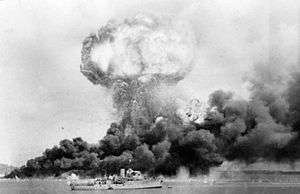
Meanwhile, Japanese aircraft had all but eliminated Allied air power in Southeast Asia[83] and were making attacks on northern Australia, beginning with a psychologically devastating but militarily insignificant attack on the city of Darwin[83] on 19 February, which killed at least 243 people.
At the Battle of the Java Sea in late-February and early-March, the Imperial Japanese Navy (IJN) inflicted a resounding defeat on the main ABDA naval force, under Admiral Karel Doorman.[84] The Dutch East Indies campaign subsequently ended with the surrender of Allied forces on Java[85] and Sumatra.[86]
In March and April, a powerful IJN carrier force launched a raid into the Indian Ocean. British Royal Navy bases in Ceylon were hit and the aircraft carrier HMS Hermes and other Allied ships were sunk. The attack forced the Royal Navy to withdraw to the western part of the Indian Ocean.[87] This paved the way for a Japanese assault on Burma and India.
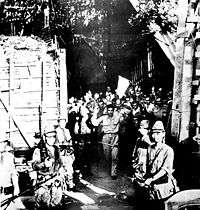
In Burma, the British, under intense pressure, made a fighting retreat from Rangoon to the Indo-Burmese border. This cut the Burma Road, which was the western Allies' supply line to the Chinese Nationalists. In March 1942, the Chinese Expeditionary Force started to attack Japanese forces in northern Burma. On 16 April, 7,000 British soldiers were encircled by the Japanese 33rd Division during the Battle of Yenangyaung and rescued by the Chinese 38th Division, led by Sun Li-jen.[88] Cooperation between the Chinese Nationalists and the Communists had waned from its zenith at the Battle of Wuhan, and the relationship between the two had gone sour as both attempted to expand their areas of operation in occupied territories. The Japanese exploited this lack of unity to press ahead in their offensives.
Filipino and US forces resisted in the Philippines until 8 May 1942, when more than 80,000 soldiers were ordered to surrender. By this time, General Douglas MacArthur, who had been appointed Supreme Allied Commander South West Pacific, had been withdrawn to Australia. The US Navy, under Admiral Chester Nimitz, had responsibility for the rest of the Pacific Ocean. This divided command had unfortunate consequences for the commerce war,[89] and consequently, the war itself.
Threat to Australia
In late 1941, as the Japanese struck at Pearl Harbor, most of Australia's best forces were committed to the fight against Hitler in the Mediterranean Theatre. Australia was ill-prepared for an attack, lacking armaments, modern fighter aircraft, heavy bombers, and aircraft carriers. While still calling for reinforcements from Churchill, the Australian Prime Minister John Curtin called for American support with a historic announcement on 27 December 1941:[90][91]
The Australian Government ... regards the Pacific struggle as primarily one in which the United States and Australia must have the fullest say in the direction of the democracies' fighting plan. Without inhibitions of any kind, I make it clear that Australia looks to America, free of any pangs as to our traditional links or kinship with the United Kingdom.
— Prime Minister John Curtin
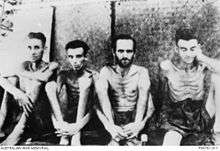
Australia had been shocked by the speedy collapse of British Malaya and Fall of Singapore in which around 15,000 Australian soldiers became prisoners of war. Curtin predicted the "battle for Australia" would now follow. The Japanese established a major base in the Australian Territory of New Guinea in early 1942.[92] On 19 February, Darwin suffered a devastating air raid, the first time the Australian mainland had been attacked. Over the following 19 months, Australia was attacked from the air almost 100 times.
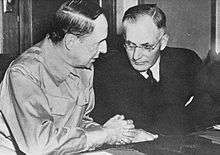
Two battle-hardened Australian divisions were steaming from the Mid-East for Singapore. Churchill wanted them diverted to Burma, but Curtin insisted on a return to Australia. In early 1942 elements of the Imperial Japanese Navy proposed an invasion of Australia. The Imperial Japanese Army opposed the plan and it was rejected in favour of a policy of isolating Australia from the United States via blockade by advancing through the South Pacific.[93] The Japanese decided upon a seaborne invasion of Port Moresby, capital of the Australian Territory of Papua which would put Northern Australia within range of Japanese bomber aircraft.
President Franklin Roosevelt ordered General Douglas MacArthur in the Philippines to formulate a Pacific defence plan with Australia in March 1942. Curtin agreed to place Australian forces under the command of MacArthur who became Supreme Commander, South West Pacific. MacArthur moved his headquarters to Melbourne in March 1942 and American troops began massing in Australia. Enemy naval activity reached Sydney in late May 1942, when Japanese midget submarines launched a daring raid on Sydney Harbour. On 8 June 1942, two Japanese submarines briefly shelled Sydney's eastern suburbs and the city of Newcastle.[94]
Allies re-group, 1942–43
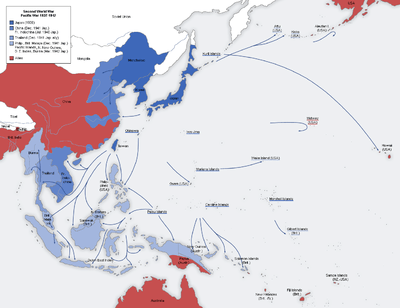
In early 1942, the governments of smaller powers began to push for an inter-governmental Asia–Pacific war council, based in Washington, DC. A council was established in London, with a subsidiary body in Washington. However, the smaller powers continued to push for an American-based body. The Pacific War Council was formed in Washington, on 1 April 1942, with President Franklin D. Roosevelt, his key advisor Harry Hopkins, and representatives from Britain, China, Australia, the Netherlands, New Zealand, and Canada. Representatives from India and the Philippines were later added. The council never had any direct operational control, and any decisions it made were referred to the US–UK Combined Chiefs of Staff, which was also in Washington. Allied resistance, at first symbolic, gradually began to stiffen. Australian and Dutch forces led civilians in a prolonged guerilla campaign in Portuguese Timor.
Japanese strategy and the Doolittle raid
.jpg)
Having accomplished their objectives during the First Operation Phase with ease, the Japanese now turned to the second.[95] The Second Operational Phase planned to expand Japan's strategic depth by adding eastern New Guinea, New Britain, the Aleutians, Midway, the Fiji Islands, Samoa, and strategic points in the Australian area.[96] However, the Naval General Staff, the Combined Fleet, and the Imperial Army, all had different strategies on the next sequence of operations. The Naval General Staff advocated an advance to the south to seize parts of Australia. However, with large numbers of troops still engaged in China combined with those stationed in Manchuria facing the Soviet Union, the Imperial Japanese Army declined to contribute the forces necessary for such an operation,[96] this quickly led to the abandonment of the concept. The Naval General Staff still wanted to cut the sea links between Australia and the United States by capturing New Caledonia, Fiji, and Samoa. Since this required far fewer troops, on March 13 the Naval General Staff and the Army agreed to operations with the goal of capturing Fiji and Samoa.[96] The Second Operational Phase began well when Lae and Salamaua, located in eastern New Guinea, were captured on March 8. However, on March 10, American carrier aircraft attacked the invasion forces and inflicted considerable losses. The raid had major operational implications since it forced the Japanese to stop their advance in the South Pacific, until the Combined Fleet provided the means to protect future operations from American carrier attack.[96] Concurrently, the Doolittle Raid occurred in April 1942, where 16 bombers took off from the aircraft carrier USS Hornet, 600 miles (970 km) from Japan. The raid inflicted minimal material damage on Japanese soil but was a huge morale boost for the United States, it also had major psychological repercussions in Japan, in exposing the vulnerabilities of the Japanese homeland.[97] As the raid was mounted by a carrier task force, it consequently highlighted to the dangers the Japanese home islands could face until the destruction of the American carrier forces was achieved.[98] With only Marcus Island and a line of converted trawlers patrolling the vast waters that separate Wake and Kamchatka, the Japanese east coast was left open to attack.[98]
Admiral Yamamoto now perceived that was it was essential to complete the destruction of the United States Navy, which had begun at Pearl Harbor.[96] His proposal to achieve this was by attacking and occupying Midway Atoll an objective, which he assessed, the Americans would be certain to fight for as they would be forced to contest a Japanese invasion there since it was close enough to Hawaii.[99] During a series of meetings held from April 2–5, between the Naval General Staff and representatives of the Combined Fleet reached a compromise. Yamamoto got his Midway operation, but only after he had threatened to resign. In return, however, Yamamoto had to agree to two demands from the Naval General Staff both of which had implications for the Midway operation. In order to cover the offensive in the South Pacific, Yamamoto agreed to allocate one carrier division to the operation against Port Moresby. Yamamoto also agreed to include an attack to seize strategic points in the Aleutian Islands simultaneously with the Midway operation, these were enough to remove the Japanese margin of superiority in the coming Midway attack.[100]
Coral Sea
%2C_8_May_1942_(80-G-16651).jpg)
The attack on Port Moresby was codenamed the MO Operation and was divided into several parts or phases. In the first, Tulagi would be occupied on May 3, the carriers would then conduct a wide sweep through the Coral Sea to find and attack and destroy Allied naval forces, with the landings conducted to capture Port Moresby scheduled for May 10.[100] The MO Operation featured a force of 60 ships led by the two carriers: Shōkaku and Zuikaku, one light carrier (Shōhō), six heavy cruisers, three light cruisers, and 15 destroyers.[100] Additionally, some 250 aircraft were assigned to the operation including 140 aboard the three carriers.[100] However, the actual battle did not go according to plan, although Tulagi was seized on May 3, the following day, aircraft from the American carrier Yorktown struck the invasion force.[100] The element of surprise, which had been present at Pearl Harbor, was now lost due to the success of Allied codebreakers who had discovered the attack would be against Port Moresby. From the Allied point of view if Port Moresby fell, the Japanese would control the seas to the north and west of Australia and could isolate the country. An Allied task force under the command of Admiral Fletcher, with the carriers USS Lexington and USS Yorktown was assembled to stop the Japanese advance. For the next two days, both the American and Japanese carrier forces tried unsuccessfully to locate each other. On May 7, the Japanese carriers launched a full strike on a contact reported to be enemy carriers, the report though turned out to be false. The strike force found and struck only an oiler, the Neosho and the destroyer Sims.[101] The American carriers also launched a strike with incomplete reconnaissance, instead of finding the main Japanese carrier force, they only located and sank the Shōhō. On May 8, the opposing carrier forces finally found each other and exchanged air strikes. The 69 aircraft from the two Japanese carriers succeeded in sinking the carrier Lexington and damaging Yorktown, in return the Americans damaged the Shōkaku. Although Zuikaku was the left undamaged, aircraft and personnel losses to Zuikaku were heavy and the Japanese were unable to support a landing on Port Moresby. As a result, the MO Operation was cancelled,[102] and the Japanese were subsequently forced to abandon their attempts to isolate Australia.[103] Although they managed to sink a carrier, the battle was a disaster for the Japanese. Not only was the attack on Port Moresby halted, which constituted the first strategic Japanese setback of the war, but all three carriers that were committed to the battle would now be unavailable for the operation against Midway.[102] The Battle of the Coral Sea was the first naval battle fought in which ships involved never sighted each other, with attacks solely by aircraft.
After Coral Sea, the Japanese had four fleet carriers operational—Sōryū, Kaga, Akagi and Hiryū—and believed that the Americans had a maximum of two—Enterprise and Hornet. Saratoga was out of action, undergoing repair after a torpedo attack, while Yorktown had been damaged at Coral Sea and was believed by Japanese naval intelligence to have been sunk. She would, in fact, sortie for Midway after just three days' of repairs to her flight deck, with civilian work crews still aboard, in time to be present for the next decisive engagement.
Midway
.jpg)
Admiral Yamamoto viewed the operation against Midway as the potentially decisive battle of the war which could lead to the destruction of American strategic power in the Pacific,[104] and subsequently open the door for a negotiated peace settlement with the United States, favorable to Japan.[102] For the operation, the Japanese had only four carriers; Akagi, Kaga, Sōryū and Hiryū. Through strategic and tactical surprise, the Japanese would knock out Midway's air strength and soften it for a landing by 5,000 troops.[102] After the quick capture of the island, the Combined Fleet would lay the basis for the most important part of the operation. Yamamoto hoped that the attack would lure the Americans into a trap.[105] Midway was to be bait for the USN which would depart Pearl Harbor to counterattack after Midway had been captured. When the Americans arrived, he would concentrate his scattered forces to defeat them. An important aspect of the scheme was Operation AL, which was the plan to seize two islands in the Aleutians, concurrently with the attack on Midway.[102] Contradictory to persistent myth, the Aleutian operation was not a diversion to draw American forces from Midway, as the Japanese wanted the Americans to be drawn to Midway, rather than away from it.[106] However, in May, Allied codebreakers discovered the planned attack on Midway. Yamamoto's complex plan had no provision for intervention by the American fleet before the Japanese had expected them. Planned surveillance of the American fleet in Pearl Harbor by long-ranged seaplane did not happen as a result of an abortive identical operation in March. Planned detection of the American departure by submarine patrol line faltered on their late departure, a product of Nagumo's hasty sortie.[107]
The battle began on June 3, when American aircraft from Midway spotted and attacked the Japanese transport group 700 miles (1,100 km) west of the atoll.[106] On June 4, the Japanese launched a 108-aircraft strike on the island, the attackers brushing aside Midway's defending fighters but failing to deliver a decisive blow to the island's facilities.[108] Most importantly, the strike aircraft based on Midway had already departed to attack the Japanese carriers, which had been spotted. This information was passed to the three American carriers and a total of 116 carrier aircraft, in addition to those from Midway, were on their way to attack the Japanese. The aircraft from Midway attacked, but failed to score a single hit on the Japanese. In the middle of these uncoordinated attacks, a Japanese scout aircraft reported the presence of an American task force, but it was not until later that the presence of an American carrier was confirmed.[108] Vice Admiral Chuichi Nagumo, was put in a difficult tactical situation in which he had to counter continuous American air attacks and prepare to recover his Midway strike, while deciding whether to mount an immediate strike on the American carrier or wait to prepare a proper attack.[109] After quick deliberation, he opted for a delayed but better-prepared attack on the American task force after recovering his Midway strike and properly arming aircraft.[109] However, beginning at 10.22am, American SBD Dauntlesses surprised and successfully attacked three of the Japanese carriers.[109] With their decks laden with fully fueled and armed aircraft, Sōryū, Kaga, and Akagi were turned into blazing wrecks. A Japanese single carrier, Hiryū, remained operational, and launched an immediate counterattack. Both of her attacks hit Yorktown and put her out of action. Later in the afternoon, aircraft from the two remaining American carriers found and destroyed Hiryū. The crippled Yorktown, along with the destroyer Hammann, were both sunk by the Japanese submarine I-168. With the striking power of the Kido Butai having been destroyed, Japan's offensive power was blunted. Early on the morning of June 5, with the battle lost, the Japanese cancelled the Midway operation and the initiative in the Pacific was in the balance.[110] Although losing four carriers, Parshall and Tully note losses at Midway did not radically degrade the fighting capabilities of Japanese naval aviation as a whole.[111]
New Guinea and the Solomons
Japanese land forces continued to advance in the Solomon Islands and New Guinea. From July 1942, a few Australian reserve battalions, many of them very young and untrained, fought a stubborn rearguard action in New Guinea, against a Japanese advance along the Kokoda Track, towards Port Moresby, over the rugged Owen Stanley Ranges. The militia, worn out and severely depleted by casualties, were relieved in late August by regular troops from the Second Australian Imperial Force, returning from action in the Mediterranean theater. In early September 1942 Japanese marines attacked a strategic Royal Australian Air Force base at Milne Bay, near the eastern tip of New Guinea. They were beaten back by Allied (primarily Australian Army) forces.
Guadalcanal
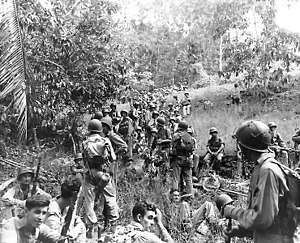
At the same time as major battles raged in New Guinea, Allied forces became aware of a Japanese airfield under construction at Guadalcanal through coastwatchers.[112] On August 7, US Marines landed on the islands of Guadalcanal and Tulagi in the Solomons. Vice Admiral Gunichi Mikawa, commander of the newly formed Eighth Fleet at Rabaul, reacted quickly. Gathering five heavy cruisers, two light cruisers, and a destroyer, sailed to engage the Allied force off the coast of Guadalcanal. On the night of August 8–9, Mikawa's quick response resulted in a brilliant victory during which four Allied heavy cruisers were sunk.[110] No Japanese ships were lost, it was one of the worst Allied naval defeats of the war.[110] The victory was only mitigated by the failure of the Japanese to attack the vulnerable transports. Had it been done so, the first American counterattack in the Pacific could have been stopped. The Japanese originally perceived the American landings as nothing more than a reconnaissance in force.[113]
With Japanese and Allied forces occupying various parts of the island, over the following six months both sides poured resources into an escalating battle of attrition on land, at sea, and in the sky. Most of the Japanese aircraft based in the South Pacific were redeployed to the defense of Guadalcanal. Many were lost in numerous engagements with the Allied air forces based at Henderson Field as well as carrier based aircraft. Meanwhile, Japanese ground forces launched repeated attacks on heavily defended US positions around Henderson Field, in which they suffered appalling casualties. To sustain these offensives, resupply was carried out by Japanese convoys, termed the "Tokyo Express" by the Allies. The convoys often faced night battles with enemy naval forces in which they expended destroyers that the IJN could ill-afford to lose. Later fleet battles involving heavier ships and even daytime carrier battles resulted in a stretch of water near Guadalcanal becoming known as "Ironbottom Sound" from the multitude of ships sunk on both sides. However, the Allies were much better able to replace these losses. Finally recognizing that the campaign to recapture Henderson Field and secure Guadalcanal had simply become too costly to continue, the Japanese evacuated the island and withdrew in February 1943. In the six-month war of attrition, the Japanese had lost as a result of failing to commit enough forces in sufficient time.[114]
Allied advances in New Guinea and the Solomons
%2C_New_Guinea.jpg)
By late 1942, Japanese headquarters decided to make Guadalcanal their priority. They ordered the Japanese on the Kokoda Track, within sight of the lights of Port Moresby, to retreat to the northeastern coast of New Guinea. Australian and US forces attacked their fortified positions and after more than two months of fighting in the Buna–Gona area finally captured the key Japanese beachhead in early 1943.
In June 1943, the Allies launched Operation Cartwheel, which defined their offensive strategy in the South Pacific. The operation was aimed at isolating the major Japanese forward base at Rabaul and cutting its supply and communication lines. This prepared the way for Nimitz's island-hopping campaign towards Japan.
Stalemate in China and Southeast Asia
China 1942–1943
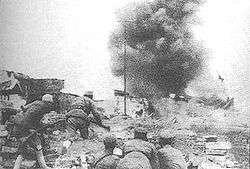
In mainland China, the Japanese 3rd, 6th, and 40th Divisions, a grand total of around 120,000 troops, massed at Yueyang and advanced southward in three columns, attempting again to cross the Miluo River to reach Changsha. In January 1942, Chinese forces scored a victory at Changsha, the first Allied success against Japan.[115]
After the Doolittle Raid, the Imperial Japanese Army conducted the Zhejiang-Jiangxi Campaign, with the goal of searching out the surviving American airmen, applying retribution on the Chinese who aided them, and destroying air bases. This operation started on 15 May 1942 with 40 infantry and 15–16 artillery battalions, but was repelled by Chinese forces in September.[116] During this campaign, the Imperial Japanese Army left behind a trail of devastation and also spread cholera, typhoid, plague and dysentery pathogens. Chinese estimates put the death toll at 250,000 civilians. Around 1,700 Japanese troops died, out of a total 10,000 who fell ill when their biological weapons rebounded on their own forces.[117][118][119]
On 2 November 1943, Isamu Yokoyama, commander of the Imperial Japanese 11th Army, deployed the 39th, 58th, 13th, 3rd, 116th and 68th Divisions, a total of around 100,000 troops, to attack Changde of China.[120] During the seven-week Battle of Changde, the Chinese forced Japan to fight a costly campaign of attrition. Although the Imperial Japanese Army initially successfully captured the city, the Chinese 57th Division was able to pin them down long enough for reinforcements to arrive and encircle the Japanese. The Chinese then cut Japanese supply lines, provoking a retreat and Chinese pursuit.[120][121] During the battle, Japan used chemical weapons.[122]
Burma 1942–1943
In the aftermath of the Japanese conquest of Burma, there was widespread disorder and pro-Independence agitation in eastern India and a disastrous famine in Bengal, which ultimately caused up to 3 million deaths. In spite of these, and inadequate lines of communication, British and Indian forces attempted limited counter-attacks in Burma in early 1943. An offensive in Arakan failed, ignominiously in the view of some senior officers,[123] while a long distance raid mounted by the Chindits under Brigadier Orde Wingate suffered heavy losses, but was publicized to bolster Allied morale. It also provoked the Japanese to mount major offensives themselves the following year.
In August 1943 the Allies formed a new South East Asia Command (SEAC) to take over strategic responsibilities for Burma and India from the British India Command, under Wavell. In October 1943 Winston Churchill appointed Admiral Lord Louis Mountbatten as its Supreme Commander. The British and Indian Fourteenth Army was formed to face the Japanese in Burma. Under Lieutenant General William Slim, its training, morale and health greatly improved. The American General Joseph Stilwell, who also was deputy commander to Mountbatten and commanded US forces in the China Burma India Theater, directed aid to China and prepared to construct the Ledo Road to link India and China by land.
Allied offensives, 1943–44

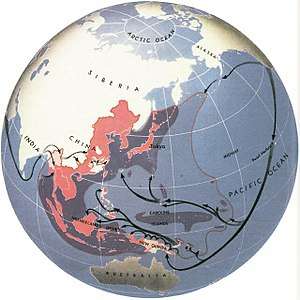
Midway proved to be the last great naval battle for two years. The United States used the ensuing period to turn its vast industrial potential into increased numbers of ships, planes, and trained aircrew.[124] At the same time, Japan, lacking an adequate industrial base or technological strategy, a good aircrew training program, or adequate naval resources and commerce defense, fell further and further behind. In strategic terms the Allies began a long movement across the Pacific, seizing one island base after another. Not every Japanese stronghold had to be captured; some, like Truk, Rabaul, and Formosa, were neutralized by air attack and bypassed. The goal was to get close to Japan itself, then launch massive strategic air attacks, improve the submarine blockade, and finally (only if necessary) execute an invasion.
In November 1943 US Marines sustained high casualties when they overwhelmed the 4,500-strong garrison at Tarawa. This helped the Allies to improve the techniques of amphibious landings, learning from their mistakes and implementing changes such as thorough pre-emptive bombings and bombardment, more careful planning regarding tides and landing craft schedules, and better overall coordination.
The US Navy did not seek out the Japanese fleet for a decisive battle, as Mahanian doctrine would suggest (and as Japan hoped); the Allied advance could only be stopped by a Japanese naval attack, which oil shortages (induced by submarine attack) made impossible.[70][89]
Cairo Conference
On 22 November 1943 US President Franklin D. Roosevelt, British Prime Minister Winston Churchill, and ROC Generalissimo Chiang Kai-shek, met in Cairo, Egypt, to discuss a strategy to defeat Japan. The meeting was also known as the Cairo Conference and concluded with the Cairo Declaration.
Submarine warfare
US submarines, as well as some British and Dutch vessels, operating from bases at Cavite in the Philippines (1941–42); Fremantle and Brisbane, Australia; Pearl Harbor; Trincomalee, Ceylon; Midway; and later Guam, played a major role in defeating Japan, even though submarines made up a small proportion of the Allied navies—less than two percent in the case of the US Navy.[89][125] Submarines strangled Japan by sinking its merchant fleet, intercepting many troop transports, and cutting off nearly all the oil imports essential to weapons production and military operations. By early 1945, Japanese oil supplies were so limited that its fleet was virtually stranded.
The Japanese military claimed its defenses sank 468 Allied submarines during the war.[126] In reality, only 42 American submarines were sunk in the Pacific due to hostile action, with 10 others lost in accidents or as the result of friendly fire.[127] The Dutch lost five submarines due to Japanese attack or minefields,[128] and the British lost three.
American submarines accounted for 56% of the Japanese merchantmen sunk; mines or aircraft destroyed most of the rest.[127] American submariners also claimed 28% of Japanese warships destroyed.[129] Furthermore, they played important reconnaissance roles, as at the battles of the Philippine Sea (June 1944) and Leyte Gulf (October 1944) (and, coincidentally, at Midway in June 1942), when they gave accurate and timely warning of the approach of the Japanese fleet. Submarines also rescued hundreds of downed fliers, including future US president George H. W. Bush.
Allied submarines did not adopt a defensive posture and wait for the enemy to attack. Within hours of the Pearl Harbor attack, in retribution against Japan, Roosevelt promulgated a new doctrine: unrestricted submarine warfare against Japan. This meant sinking any warship, commercial vessel, or passenger ship in Axis-controlled waters, without warning and without aiding survivors.[lower-alpha 13] At the outbreak of the war in the Pacific, the Dutch admiral in charge of the naval defense of the East Indies, Conrad Helfrich, gave instructions to wage war aggressively. His small force of submarines sank more Japanese ships in the first weeks of the war than the entire British and US navies together, an exploit which earned him the nickname "Ship-a-day Helfrich".[130]
While Japan had a large number of submarines, they did not make a significant impact on the war. In 1942, the Japanese fleet submarines performed well, knocking out or damaging many Allied warships. However, Imperial Japanese Navy (and pre-war US) doctrine stipulated that only fleet battles, not guerre de course (commerce raiding) could win naval campaigns. So, while the US had an unusually long supply line between its west coast and frontline areas, leaving it vulnerable to submarine attack, Japan used its submarines primarily for long-range reconnaissance and only occasionally attacked US supply lines. The Japanese submarine offensive against Australia in 1942 and 1943 also achieved little.[131]
As the war turned against Japan, IJN submarines increasingly served to resupply strongholds which had been cut off, such as Truk and Rabaul. In addition, Japan honored its neutrality treaty with the Soviet Union and ignored American freighters shipping millions of tons of military supplies from San Francisco to Vladivostok,[132] much to the consternation of its German ally.
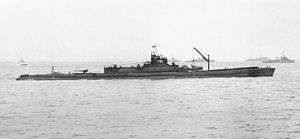
The US Navy, by contrast, relied on commerce raiding from the outset. However, the problem of Allied forces surrounded in the Philippines, during the early part of 1942, led to diversion of boats to "guerrilla submarine" missions. Basing in Australia placed boats under Japanese aerial threat while en route to patrol areas, reducing their effectiveness, and Nimitz relied on submarines for close surveillance of enemy bases. Furthermore, the standard-issue Mark 14 torpedo and its Mark VI exploder both proved defective, problems which were not corrected until September 1943. Worst of all, before the war, an uninformed US Customs officer had seized a copy of the Japanese merchant marine code (called the "maru code" in the USN), not knowing that the Office of Naval Intelligence (ONI) had broken it.[133] The Japanese promptly changed it, and the new code was not broken again by OP-20-G until 1943.
Thus, only in 1944 did the US Navy begin to use its 150 submarines to maximum effect: installing effective shipboard radar, replacing commanders deemed lacking in aggression, and fixing the faults in the torpedoes. Japanese commerce protection was "shiftless beyond description,"[lower-alpha 14] and convoys were poorly organized and defended compared to Allied ones, a product of flawed IJN doctrine and training – errors concealed by American faults as much as Japanese overconfidence. The number of American submarines patrols (and sinkings) rose steeply: 350 patrols (180 ships sunk) in 1942, 350 (335) in 1943, and 520 (603) in 1944.[135] By 1945, sinkings of Japanese vessels had decreased because so few targets dared to venture out on the high seas. In all, Allied submarines destroyed 1,200 merchant ships – about five million tons of shipping. Most were small cargo carriers, but 124 were tankers bringing desperately needed oil from the East Indies. Another 320 were passenger ships and troop transports. At critical stages of the Guadalcanal, Saipan, and Leyte campaigns, thousands of Japanese troops were killed or diverted from where they were needed. Over 200 warships were sunk, ranging from many auxiliaries and destroyers to one battleship and no fewer than eight carriers.
Underwater warfare was especially dangerous; of the 16,000 Americans who went out on patrol, 3,500 (22%) never returned, the highest casualty rate of any American force in World War II.[136] The Joint Army–Navy Assessment Committee assessed US submarine credits.[137][138] The Japanese losses, 130 submarines in all,[139] were higher.[140]
Japanese counteroffensives in China, 1944
In mid-1944 Japan mobilized over 500,000 men[141] and launched a massive operation across China under the code name Operation Ichi-Go, their largest offensive of World War II, with the goal of connecting Japanese-controlled territory in China and French Indochina and capturing airbases in southeastern China where American bombers were based.[142] During this time, about 250,000 newly American-trained Chinese troops under Joseph Stilwell and Chinese expeditionary force were forcibly locked in the Burmese theater by the terms of the Lend-Lease Agreement.[142] Though Japan suffered about 100,000 casualties,[143] these attacks, the biggest in several years, gained much ground for Japan before Chinese forces stopped the incursions in Guangxi. Despite major tactical victories, the operation overall failed to provide Japan with any significant strategic gains. A great majority of the Chinese forces were able to retreat out of the area, and later come back to attack Japanese positions at the Battle of West Hunan. Japan was not any closer to defeating China after this operation, and the constant defeats the Japanese suffered in the Pacific meant that Japan never got the time and resources needed to achieve final victory over China. Operation Ichi-go created a great sense of social confusion in the areas of China that it affected. Chinese Communist guerrillas were able to exploit this confusion to gain influence and control of greater areas of the countryside in the aftermath of Ichi-go.[144]
Japanese offensive in India, 1944
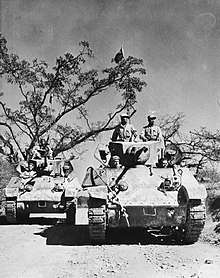
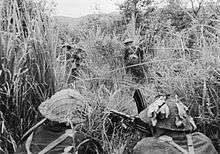
After the Allied setbacks in 1943, the South East Asia command prepared to launch offensives into Burma on several fronts. In the first months of 1944, the Chinese and American troops of the Northern Combat Area Command (NCAC), commanded by the American Joseph Stilwell, began extending the Ledo Road from India into northern Burma, while the XV Corps began an advance along the coast in Arakan Province. In February 1944 the Japanese mounted a local counter-attack in Arakan. After early Japanese success, this counter-attack was defeated when the Indian divisions of XV Corps stood firm, relying on aircraft to drop supplies to isolated forward units until reserve divisions could relieve them.
The Japanese responded to the Allied attacks by launching an offensive of their own into India in the middle of March, across the mountainous and densely forested frontier. This attack, codenamed Operation U-Go, was advocated by Lieutenant General Renya Mutaguchi, the recently promoted commander of the Japanese Fifteenth Army; Imperial General Headquarters permitted it to proceed, despite misgivings at several intervening headquarters. Although several units of the British Fourteenth Army had to fight their way out of encirclement, by early April they had concentrated around Imphal in Manipur state. A Japanese division which had advanced to Kohima in Nagaland cut the main road to Imphal, but failed to capture the whole of the defences at Kohima. During April, the Japanese attacks against Imphal failed, while fresh Allied formations drove the Japanese from the positions they had captured at Kohima.
As many Japanese had feared, Japan's supply arrangements could not maintain her forces. Once Mutaguchi's hopes for an early victory were thwarted, his troops, particularly those at Kohima, starved. During May, while Mutaguchi continued to order attacks, the Allies advanced southwards from Kohima and northwards from Imphal. The two Allied attacks met on 22 June, breaking the Japanese siege of Imphal. The Japanese finally broke off the operation on 3 July. They had lost over 50,000 troops, mainly to starvation and disease. This represented the worst defeat suffered by the Imperial Japanese Army to that date.[145]
Although the advance in Arakan had been halted to release troops and aircraft for the Battle of Imphal, the Americans and Chinese had continued to advance in northern Burma, aided by the Chindits operating against the Japanese lines of communication. In the middle of 1944 the Chinese Expeditionary Force invaded northern Burma from Yunnan. They captured a fortified position at Mount Song.[146] By the time campaigning ceased during the monsoon rains, the NCAC had secured a vital airfield at Myitkyina (August 1944), which eased the problems of air resupply from India to China over "The Hump".
Beginning of the end in the Pacific, 1944
In May 1943, the Japanese prepared Operation Z or the Z Plan, which envisioned the use of Japanese naval power to counter American forces threatening the outer defense perimeter line. This line extended from the Aleutians down through Wake, the Marshall and Gilbert Islands, Nauru, the Bismarck Archipelago, New Guinea, then westward past Java and Sumatra to Burma.[147] In 1943-44, Allied forces in the Solomons began driving relentlessly to Rabaul, eventually encircling and neutralizing the stronghold. With their position in the Solomons disintegrating, the Japanese modified the Z Plan by eliminating the Gilbert and Marshall Islands, and the Bismarck Archipelago as vital areas to be defended. They then based their possible actions on the defense of an inner perimeter, which included the Marianas, Palau, Western New Guinea, and the Dutch East Indies. Meanwhile, in the Central Pacific the Americans initiated a major offensive, beginning in November 1943 with landings in the Gilbert Islands.[148] The Japanese were forced to watch helplessly as their garrisons in the Gilberts and then the Marshalls were crushed.[148] The strategy of holding overextended island garrisons was fully exposed.[149]
In February 1944, the US Navy's fast carrier task force, during Operation Hailstone, attacked the major naval base of Truk. Although the Japanese had moved their major vessels out in time to avoid being caught at anchor in the atoll, two days of air attacks resulted in significant losses to Japanese aircraft and merchant shipping.[149] The Japanese were forced to abandon Truk and were now unable to counter the Americans on any front on the perimeter. Consequently, the Japanese retained their remaining strength in preparation for what they hoped would be a decisive battle.[149] The Japanese then developed a new plan, known as A-GO. A-GO envisioned a decisive fleet action that would be fought somewhere from the Palaus to the Western Carolines.[150] It was in this area that the newly formed Mobile Fleet along with large numbers of land-based aircraft, would be concentrated. If the Americans attacked the Marianas, they would be attacked by land-based planes in the vicinity. Then the Americans would be lured into the areas where the Mobile Fleet could defeat them.[150]
The Marianas and the Philippine Sea
.jpg)
On 15 June 1944, 535 ships began landing 128,000 US Army and Marine Corps personnel on the island of Saipan in the Northern Marianas. The Allies aimed to establish airfields near enough the Japanese Home Islands, including Honshu, the location of Tokyo, to allow their bombing with the new Boeing B-29 Superfortress. The ability to plan and execute such a complex operation in the space of 90 days was indicative of Allied logistical superiority.
Japanese commanders saw holding Saipan as imperative. The only way to do so involved destroying the U.S. Fifth Fleet, which had 15 fleet carriers and 956 planes, 7 battleships, 28 submarines, and 69 destroyers, as well as several light and heavy cruisers. Vice Admiral Jisaburō Ozawa attacked with nine-tenths of Japan's fighting fleet, which included nine carriers with 473 planes, 5 battleships, several cruisers, and 28 destroyers. Ozawa's pilots were outnumbered 2:1 and their aircraft were becoming or were already obsolete. The Japanese had considerable antiaircraft defenses but lacked proximity fuzes or good radar. With the odds against him, Ozawa devised an appropriate strategy. His planes had greater range because they were not weighed down with protective armor; they could attack at about 480 km (300 mi), and could search a radius of 900 km (560 mi). U.S. Navy Hellcat fighters could attack only within 200 miles (320 km) and search only within a 325-mile (523 km) radius. Ozawa planned to use this advantage by positioning his fleet 300 miles (480 km) out. The Japanese planes would hit the U.S. carriers, land at Guam to refuel, then hit the enemy again when returning to their carriers. Ozawa also counted on about 500 land-based planes at Guam and other islands.
Admiral Raymond A. Spruance had overall command of the U.S. Fifth Fleet. The Japanese plan would have failed if the much larger U.S. fleet had closed on Ozawa and attacked aggressively; Ozawa correctly inferred Spruance would not attack. U.S. Admiral Marc Mitscher, in tactical command of Task Force 58, with its 15 carriers, was aggressive, but Spruance vetoed Mitscher's plan to hunt down Ozawa because Spruance's orders made protecting the landings on Saipan his first priority.
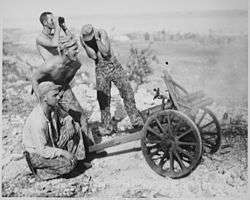
The forces converged in the largest sea-battle of World War II up to that point - the Battle of the Philippine Sea (19–20 June 1944). Over the previous month American destroyers had destroyed 17 of 25 submarines out of Ozawa's screening force.[151][152] Repeated US raids destroyed the Japanese land-based planes. Ozawa's main attack lacked coordination, with the Japanese planes arriving at their targets in a staggered sequence. Following a directive from Nimitz, the US carriers all had combat-information centers, which interpreted the flow of radar data and radioed interception orders to the Hellcats. The result was later dubbed the Great Marianas Turkey Shoot. The few attackers to reach the US fleet encountered massive AA fire with proximity fuzes. Only one American warship was slightly damaged.
On the second day, US reconnaissance planes located Ozawa's fleet, 275 miles (443 km) away, and submarines sank two Japanese carriers. Mitscher launched 230 torpedo planes and dive bombers. He then discovered the enemy was actually another 60 miles (97 km) further off, out of aircraft range (based on a roundtrip flight). Mitscher decided this chance to destroy the Japanese fleet was worth the risk of aircraft losses due to running out of fuel on the return flight. Overall, the US lost 130 planes and 76 aircrew; however, Japan lost 450 planes, three carriers, and 445 aircrew. US aircraft had effectively destroyed the Imperial Japanese Navy's carrier force.[153]
A month after the invasion of Saipan, the US recaptured Guam and captured Tinian.
Once captured, the islands of Saipan and Tinian were used extensively by the United States military as they finally put mainland Japan within round-trip range of American B-29 bombers. In response, Japanese forces attacked the bases on Saipan and Tinian from November 1944 to January 1945. At the same time and afterwards, the United States Army Air Forces based out of these islands conducted an intense strategic bombing campaign against the Japanese cities of military and industrial importance, including Tokyo, Nagoya, Osaka, Kobe and others.
Leyte Gulf, 1944

After the disaster at Philippine Sea the Japanese were left with two choices: either to commit their remaining strength in an all-out offensive or to sit by while the Americans occupied the Philippines and cut the sea lanes between Japan and the vital resources from the Dutch East Indies and Malaya. The plan devised by the Japanese was a final attempt to create a decisive battle by utilizing their last remaining strength, which the firepower of its heavy cruisers and battleships, which were to be all committed against the American beachhead at Leyte. The Japanese planned to use their remaining carriers as bait, in order to lure the American carriers away from Leyte Gulf long enough for the heavy warships to enter and destroy any American ships present.[154]
The Japanese assembled a force totaling four carriers, nine battleships, 14 heavy cruisers, seven light cruisers, and 35 destroyers.[154] They would be split into three forces. The "Center Force", under the command of Vice Admiral Takeo Kurita, consisted of five battleships (including the Yamato and Musashi), 12 cruisers and 13 destroyers; the "Northern Force", under the command of Jisaburō Ozawa comprised four carriers, two battleships partly converted to carriers, three light cruisers and nine destroyers; the "Southern Force" contained two groups, one under the command of Shōji Nishimura consisting of two Fusō-class battleships, one heavy cruiser and four destroyers, the other under Kiyohide Shima comprised two heavy cruisers, a light cruiser and four destroyers. The main Center Force would pass through the San Bernardino Strait into the Philippine Sea, turn southwards, and then attack the landing area. The two separate groups of the Southern Force would join up and strike at the landing area through the Surigao Strait, while Northern Force with the Japanese carriers was to lure the main American covering forces away from Leyte, the carriers only embarked a total of just 108 aircraft.[154]
However, after departing from Brunei Bay on October 23, the Center Force was attacked by two American submarines which resulted in the loss of two heavy cruisers with another crippled. The next day, after entering the Sibuyan Sea on October 24, Center Force was assaulted by American carrier aircraft throughout the whole day leaving another heavy cruiser being forced to retire. The Americans then targeted the Musashi and sank it under a barrage of torpedo and bomb hits. Many other ships of Center Force were attacked, but continued on.[154] Convinced that their attacks had made Center Force ineffective, the American carriers headed north to address the newly detected threat of the Japanese carriers of Ozawa's Force. On the night of October 24–25, the Southern Force under Nishimura, attempted to enter Leyte Gulf from the south through Surigao Strait where an American-Australian force led by Rear Admiral Jesse Oldendorf, of six battleships, eight cruisers, and 26 destroyers ambushed the Japanese.[155] Utilizing radar-guided torpedo attacks, American destroyers sank one of the battleships and three destroyers while damaging the other battleship. Radar guided naval gunfire then finished off the second battleship, with only a single Japanese destroyer surviving. As a result of observing radio silence, Shima's group was unable to coordinate and synchronize its movements with Nishimura's group and subsequently arrived at Surigao Strait in the middle of the encounter; after making a haphazard torpedo attack Shima retreated.[155]
Off Cape Engaño, the Americans launched over 500 aircraft sorties at the Northern force, followed up by a surface group of cruisers and destroyers. All four Japanese carriers were sunk, but this part of the Japanese plan succeeded in drawing the American carriers away from Leyte Gulf.[155] On October 25, the final major surface action fought between the Japanese and the American fleets during the war, occurred off Samar. When Center Force fell upon a group of American escort carriers escorted by only destroyers and destroyer escorts. Both sides were surprised, but the outcome looked certain since the Japanese had four battleships, six heavy cruisers, and two light cruisers leading two destroyer squadrons. However, they did not press home their advantage, and were content to conduct a largely indecisive gunnery duel before breaking off. Japanese losses were extremely heavy with four carriers, three battleships, six heavy cruisers, four light cruisers and eleven destroyers sunk.[156] While the Americans lost three carriers, a destroyer and two destroyer escorts. The Battle of Leyte Gulf was arguably the largest naval battle in history and was the largest naval battle of World War II.
Philippines, 1944–45

On 20 October 1944 the US Sixth Army, supported by naval and air bombardment, landed on the favorable eastern shore of Leyte, north of Mindanao. The US Sixth Army continued its advance from the east, as the Japanese rushed reinforcements to the Ormoc Bay area on the western side of the island. While the Sixth Army was reinforced successfully, the US Fifth Air Force was able to devastate the Japanese attempts to resupply. In torrential rains and over difficult terrain, the advance continued across Leyte and the neighboring island of Samar to the north. On 7 December US Army units landed at Ormoc Bay and, after a major land and air battle, cut off the Japanese ability to reinforce and supply Leyte. Although fierce fighting continued on Leyte for months, the US Army was in control.
On 15 December 1944 landings against minimal resistance were made on the southern beaches of the island of Mindoro, a key location in the planned Lingayen Gulf operations, in support of major landings scheduled on Luzon. On 9 January 1945, on the south shore of Lingayen Gulf on the western coast of Luzon, General Krueger's Sixth Army landed his first units. Almost 175,000 men followed across the twenty-mile (32 km) beachhead within a few days. With heavy air support, Army units pushed inland, taking Clark Field, 40 miles (64 km) northwest of Manila, in the last week of January.
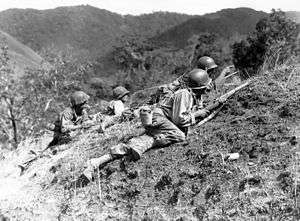
Two more major landings followed, one to cut off the Bataan Peninsula, and another, that included a parachute drop, south of Manila. Pincers closed on the city and, on 3 February 1945, elements of the 1st Cavalry Division pushed into the northern outskirts of Manila and the 8th Cavalry passed through the northern suburbs and into the city itself.
As the advance on Manila continued from the north and the south, the Bataan Peninsula was rapidly secured. On 16 February paratroopers and amphibious units assaulted the island fortress of Corregidor, and resistance ended there on 27 February.
In all, ten US divisions and five independent regiments battled on Luzon, making it the largest campaign of the Pacific War, involving more troops than the United States had used in North Africa, Italy, or southern France. Forces included the Mexican Escuadrón 201 fighter squadron as part of the Fuerza Aérea Expedicionaria Mexicana (FAEM—"Mexican Expeditionary Air Force"), with the squadron attached to the 58th Fighter Group of the United States Army Air Forces that flew tactical support missions.[157] Of the 250,000 Japanese troops defending Luzon, 80 percent died.[158] The last Japanese soldier in the Philippines to surrender was Hiroo Onoda on 9 March 1974.[159]
Palawan Island, between Borneo and Mindoro, the fifth largest and western-most Philippine Island, was invaded on 28 February with landings of the Eighth Army at Puerto Princesa. The Japanese put up little direct defense of Palawan, but cleaning up pockets of Japanese resistance lasted until late April, as the Japanese used their common tactic of withdrawing into the mountain jungles, dispersed as small units. Throughout the Philippines, US forces were aided by Filipino guerrillas to find and dispatch the holdouts.
The US Eighth Army then moved on to its first landing on Mindanao (17 April), the last of the major Philippine Islands to be taken. Mindanao was followed by invasion and occupation of Panay, Cebu, Negros and several islands in the Sulu Archipelago. These islands provided bases for the US Fifth and Thirteenth Air Forces to attack targets throughout the Philippines and the South China Sea.
Final stages

Iwo Jima, February 1945
The Battle of Iwo Jima ("Operation Detachment") in February 1945 was one of the bloodiest battles fought by the Americans in the Pacific War. Iwo Jima is an 8 sq mile (21 km2) island situated halfway between Tokyo and the Mariana Islands. Holland Smith, the commander of the invasion force, aimed to capture the island and prevent its use as an early-warning station against air raids on the Japanese Home Islands, and to use it as an emergency landing field. Lt. General Tadamichi Kuribayashi, the commander of the defense of Iwo Jima, knew that he could not win the battle, but he hoped to make the Americans suffer far more than they could endure.
From early 1944 until the days leading up to the invasion, Kuribayashi transformed the island into a massive network of bunkers, hidden guns, and 11 mi (18 km) of underground tunnels. The heavy American naval and air bombardment did little but drive the Japanese further underground, making their positions impervious to enemy fire. Their pillboxes and bunkers were all connected so that if one was knocked out, it could be reoccupied again. The network of bunkers and pillboxes greatly favored the defender.
Starting in mid-June 1944, Iwo Jima came under sustained aerial bombardment and naval artillery fire. However, Kuribayashi's hidden guns and defenses survived the constant bombardment virtually unscathed. On 19 February 1945, some 30,000 men of the 3rd, 4th, and 5th Marine Divisions landed on the southeast coast of Iwo, just under Mount Suribachi; where most of the island's defenses were concentrated. For some time, they did not come under fire. This was part of Kuribayashi's plan to hold fire until the landing beaches were full. As soon as the Marines pushed inland to a line of enemy bunkers, they came under devastating machine gun and artillery fire which cut down many of the men. By the end of the day, the Marines reached the west coast of the island, but their losses were appalling; almost 2,000 men killed or wounded.
On 23 February, the 28th Marine Regiment reached the summit of Suribachi, prompting the now famous Raising the Flag on Iwo Jima picture. Navy Secretary James Forrestal, upon seeing the flag, remarked "there will be a Marine Corps for the next 500 years". The flag raising is often cited as the most reproduced photograph of all time and became the archetypal representation not only of that battle, but of the entire Pacific War. For the rest of February, the Americans pushed north, and by 1 March, had taken two-thirds of the island. But it was not until 26 March that the island was finally secured. The Japanese fought to the last man, killing 6,800 Marines and wounding nearly 20,000 more. The Japanese losses totaled well over 20,000 men killed, and only 1,083 prisoners were taken. Historians debate whether it was strategically worth the casualties sustained.[160]
Allied offensives in Burma, 1944–45
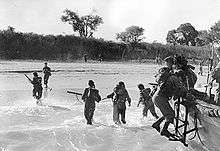
In late 1944 and early 1945, the Allied South East Asia Command launched offensives into Burma, intending to recover most of the country, including Rangoon, the capital, before the onset of the monsoon in May.
The Indian XV Corps advanced along the coast in Arakan Province, at last capturing Akyab Island after failures in the two previous years. They then landed troops behind the retreating Japanese, inflicting heavy casualties, and captured Ramree Island and Cheduba Island off the coast, establishing airfields on them which were used to support the offensive into Central Burma.
The Chinese Expeditionary Force captured Mong-Yu and Lashio,[161] while the Chinese and American Northern Combat Area Command resumed its advance in northern Burma. In late January 1945, these two forces linked up with each other at Hsipaw. The Ledo Road was completed, linking India and China, but too late in the war to have any significant effect.
The Japanese Burma Area Army attempted to forestall the main Allied attack on the central part of the front by withdrawing their troops behind the Irrawaddy River. Lieutenant General Heitarō Kimura, the new Japanese commander in Burma, hoped that the Allies' lines of communications would be overstretched trying to cross this obstacle. However, the advancing British Fourteenth Army under Lieutenant General William Slim switched its axis of advance to outflank the main Japanese armies.
During February, Fourteenth Army secured bridgeheads across the Irrawaddy on a broad front. On 1 March, units of IV Corps captured the supply centre of Meiktila, throwing the Japanese into disarray. While the Japanese attempted to recapture Meiktila, XXXIII Corps captured Mandalay. The Japanese armies were heavily defeated, and with the capture of Mandalay, the Burmese population and the Burma National Army (which the Japanese had raised) turned against the Japanese.
During April, Fourteenth Army advanced 300 miles (480 km) south towards Rangoon, the capital and principal port of Burma, but was delayed by Japanese rearguards 40 miles (64 km) north of Rangoon at the end of the month. Slim feared that the Japanese would defend Rangoon house-to-house during the monsoon, which would commit his army to prolonged action with disastrously inadequate supplies, and in March he had asked that a plan to capture Rangoon by an amphibious force, Operation Dracula, which had been abandoned earlier, be reinstated.[162] Dracula was launched on 1 May, to find that the Japanese had already evacuated Rangoon. The troops that occupied Rangoon linked up with Fourteenth Army five days later, securing the Allies' lines of communication.
The Japanese forces which had been bypassed by the Allied advances attempted to break out across the Sittaung River during June and July to rejoin the Burma Area Army which had regrouped in Tenasserim in southern Burma. They suffered 14,000 casualties, half their strength. Overall, the Japanese lost some 150,000 men in Burma. Only 1,700 prisoners were taken.[163]
The Allies were preparing to make amphibious landings in Malaya when word of the Japanese surrender arrived.
Borneo, 1945
.jpg)
The Borneo campaign of 1945 was the last major campaign in the South West Pacific Area. In a series of amphibious assaults between 1 May and 21 July, the Australian I Corps, under General Leslie Morshead, attacked Japanese forces occupying the island. Allied naval and air forces, centered on the US 7th Fleet under Admiral Thomas Kinkaid, the Australian First Tactical Air Force and the US Thirteenth Air Force also played important roles in the campaign.
The campaign opened with a landing on the small island of Tarakan on 1 May. This was followed on 1 June by simultaneous assaults in the north west, on the island of Labuan and the coast of Brunei. A week later the Australians attacked Japanese positions in North Borneo. The attention of the Allies then switched back to the central east coast, with the last major amphibious assault of World War II, at Balikpapan on 1 July.
Although the campaign was criticized in Australia at the time, and in subsequent years, as pointless or a "waste" of the lives of soldiers, it did achieve a number of objectives, such as increasing the isolation of significant Japanese forces occupying the main part of the Dutch East Indies, capturing major oil supplies and freeing Allied prisoners of war, who were being held in deteriorating conditions.[164] At one of the very worst sites, around Sandakan in Borneo, only six of some 2,500 British and Australian prisoners survived.[163]
China, 1945
By April 1945, China had already been at war with Japan for more than seven years. Both nations were exhausted by years of battles, bombings and blockades. After Japanese victories in Operation Ichi-Go, Japan was losing the battle in Burma and facing constant attacks from Chinese Nationalist forces and Communist guerrillas in the countryside. The Imperial Japanese Army began preparations for the Battle of West Hunan in March 1945. The Japanese mobilized 34th, 47th, 64th, 68th and 116th Divisions, as well as the 86th Independent Brigade, for a total of 80,000 men to seize Chinese airfields and secure railroads in West Hunan by early April.[165] In response, the Chinese National Military Council dispatched the 4th Front Army and the 10th and 27th Army Groups with He Yingqin as commander-in-chief.[166] At the same time, it airlifted the entire Chinese New 6th Corps, an American-equipped corps and veterans of the Burma Expeditionary Force, from Kunming to Zhijiang.[165] Chinese forces totaled 110,000 men in 20 divisions. They were supported by about 400 aircraft from Chinese and American air forces.[167] Chinese forces achieved a decisive victory and launched a large counterattack in this campaign. Concurrently, the Chinese managed to repel a Japanese offensive in Henan and Hubei.[166] Afterwards, Chinese forces retook Hunan and Hubei provinces in South China. Chinese launched a counter offensive to retake Guangxi which was the last major Japanese stronghold in South China. In August 1945, Chinese forces successfully retook Guangxi.
Okinawa

The largest and bloodiest American battle came at Okinawa, as the US sought airbases for 3,000 B-29 bombers and 240 squadrons of B-17 bombers for the intense bombardment of Japan's home islands in preparation for a full-scale invasion in late 1945. The Japanese, with 115,000 troops augmented by thousands of civilians on the heavily populated island, did not resist on the beaches—their strategy was to maximize the number of soldier and Marine casualties, and naval losses from Kamikaze attacks. After an intense bombardment the Americans landed on 1 April 1945 and declared victory on 21 June.[168] The supporting naval forces were the targets for 4,000 sorties, many by Kamikaze suicide planes. US losses totaled 38 ships of all types sunk and 368 damaged with 4,900 sailors killed. The Americans suffered 75,000 casualties on the ground; 94% of the Japanese soldiers died along with many civilians.[169]
The British Pacific Fleet operated as a separate unit from the American task forces in the Okinawa operation. Its objective was to strike airfields on the chain of islands between Formosa and Okinawa, to prevent the Japanese reinforcing the defences of Okinawa from that direction.
Landings in the Japanese home islands
Hard-fought battles on the Japanese home islands of Iwo Jima, Okinawa, and others resulted in horrific casualties on both sides but finally produced a Japanese defeat. Of the 117,000 Okinawan and Japanese troops defending Okinawa, 94 percent died.[158] Faced with the loss of most of their experienced pilots, the Japanese increased their use of kamikaze tactics in an attempt to create unacceptably high casualties for the Allies. The US Navy proposed to force a Japanese surrender through a total naval blockade and air raids.[170]

Towards the end of the war as the role of strategic bombing became more important, a new command for the United States Strategic Air Forces in the Pacific was created to oversee all US strategic bombing in the hemisphere, under United States Army Air Forces General Curtis LeMay. Japanese industrial production plunged as nearly half of the built-up areas of 67 cities were destroyed by B-29 firebombing raids. On 9–10 March 1945 alone, about 100,000 people were killed in a conflagration caused by an incendiary attack on Tokyo. LeMay also oversaw Operation Starvation, in which the inland waterways of Japan were extensively mined by air, which disrupted the small amount of remaining Japanese coastal sea traffic. On 26 July 1945, the President of the United States Harry S. Truman, the President of the Nationalist Government of China Chiang Kai-shek and the Prime Minister of Great Britain Winston Churchill issued the Potsdam Declaration, which outlined the terms of surrender for the Empire of Japan as agreed upon at the Potsdam Conference. This ultimatum stated that, if Japan did not surrender, it would face "prompt and utter destruction."[171]
Atomic bombs
On 6 August 1945, the US dropped an atomic bomb on the Japanese city of Hiroshima in the first nuclear attack in history. In a press release issued after the atomic bombing of Hiroshima, Truman warned Japan to surrender or "...expect a rain of ruin from the air, the like of which has never been seen on this earth."[172] Three days later, on 9 August, the US dropped another atomic bomb on Nagasaki, the last nuclear attack in history. More than 140,000–240,000 people died as a direct result of these two bombings.[173] The necessity of the atomic bombings has long been debated, with detractors claiming that a naval blockade and aerial bombing campaign had already made invasion, hence the atomic bomb, unnecessary.[174] However, other scholars have argued that the bombings shocked the Japanese government into surrender, with Emperor finally indicating his wish to stop the war. Another argument in favor of the atomic bombs is that they helped avoid Operation Downfall, or a prolonged blockade and bombing campaign, any of which would have exacted much higher casualties among Japanese civilians.[173] Historian Richard B. Frank wrote that a Soviet invasion of Japan was never likely because they had insufficient naval capability to mount an amphibious invasion of Hokkaidō.[175]
Soviet invasion of Manchuria
.jpg)
On 3 February 1945 the Soviet Union agreed with Roosevelt to enter the Pacific conflict. It promised to act 90 days after the war ended in Europe and did so exactly on schedule on 9 August by invading Manchuria. A battle-hardened, one million-strong Soviet force, transferred from Europe,[176] attacked Japanese forces in Manchuria and landed a heavy blow against the Japanese Kantōgun (Kwantung Army).[177]
The Manchurian Strategic Offensive Operation began on 9 August 1945, with the Soviet invasion of the Japanese puppet state of Manchukuo and was the last campaign of the Second World War and the largest of the 1945 Soviet–Japanese War which resumed hostilities between the Union of Soviet Socialist Republics and the Empire of Japan after almost six years of peace. Soviet gains on the continent were Manchukuo, Mengjiang (Inner Mongolia) and northern Korea. The USSR's entry into the war was a significant factor in the Japanese decision to surrender as it became apparent the Soviets were no longer willing to act as an intermediary for a negotiated settlement on favorable terms.[178]
Surrender
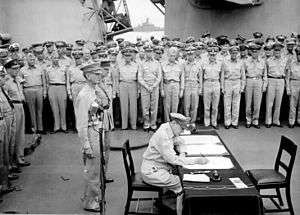
The effects of the "Twin Shocks"—the Soviet entry and the atomic bombings—were profound. On 10 August the "sacred decision" was made by Japanese Cabinet to accept the Potsdam terms on one condition: the "prerogative of His Majesty as a Sovereign Ruler". At noon on 15 August, after the American government's intentionally ambiguous reply, stating that the "authority" of the emperor "shall be subject to the Supreme Commander of the Allied Powers", the Emperor broadcast to the nation and to the world at large the rescript of surrender,[179] ending the Second World War.
Should we continue to fight, it would not only result in an ultimate collapse and obliteration of the Japanese nation, but also it would lead to the total extinction of human civilization.
— Emperor Hirohito, The Voice of the Crane: The Imperial Rescript of 15 August 1945[180]
In Japan, 14 August is considered to be the day that the Pacific War ended. However, as Imperial Japan actually surrendered on 15 August, this day became known in the English-speaking countries as V-J Day (Victory in Japan).[181] The formal Japanese Instrument of Surrender was signed on 2 September 1945, on the battleship USS Missouri, in Tokyo Bay. The surrender was accepted by General Douglas MacArthur as Supreme Commander of the Allied Powers, with representatives of several Allied nations, from a Japanese delegation led by Mamoru Shigemitsu and Yoshijirō Umezu.
Following this period, MacArthur went to Tokyo to oversee the post-war development of the country. This period in Japanese history is known as the occupation.
Casualties
Allied
United States
There were some 426,000 American casualties: 161,000 dead (including 111,914 in battle and 49,000 non-battle), 248,316 wounded, and 16,358 captured (not counting POWs who died).[18][182] Material losses were 188+ warships including 5 battleships, 11 aircraft carriers, 25 cruisers, 84 destroyers and destroyer escorts, and 63 submarines, plus 21,255 aircraft. This gave the USN a 2-1 exchange ratio with the IJN in terms of ships and aircraft.[183][184]
The US protectorate in the Philippines suffered considerable losses. Military losses were 27,000 dead (including POWs), 75,000 living POWs, and an unknown number wounded, not counting irregulars that fought in the insurgency.[185] Between 500,000 and 1,000,000 Filipino civilians died due to either war-related shortages or Japanese war crimes.[186]
China
According to official Chinese Nationalist statistics, losses to the regular National Revolutionary Army totaled 3,237,000, with 1,320,000 killed 1,797,000 wounded 120,000 missing. The soldiers of the Chinese Communist Party suffered 584,267 casualties, of which 160,603 were killed, 133,197 missing, and 290,467 wounded. This would equate to a total of 3.82 million combined NRA/CCP casualties, of which 1.74 million were killed or missing. Neither total includes the considerable number of irregular guerrilla fighters sworn to regional warlords who fought the Japanese.[187][188] Including them, an academic study published in the United States estimates Chinese military casualties at 6.75 million with 3.75 million killed or missing. The casualties break down as 1.5 million killed in battle, 750,000 missing in action, 1.5 million deaths due to disease and 3 million wounded.[189]
China suffered enormous civilian losses in the war. Estimates vary wildly, though there is a general consensus that civilian deaths were in the 17 to 22 million range, mostly from war-related causes such as famine.[190] A large number of deaths were caused directly by Japanese war crimes. For instance, 2.7 million Chinese civilians were killed in the "Three Alls" campaign.[191]
Commonwealth
Between the Malayan Campaign (130,000 discounting some 20,000 Australians),[192] Burma Campaign (86,600),[193] Battle of Hong Kong (15,000),[194] and various naval encounters, British Empire forces incurred some 235,000 casualties in the Pacific Theater, including roughly 82,000 killed (50,000 in combat and 32,000 as POWs)[195] The Royal Navy lost 23 warships in the Pacific and Indian oceans: 1 battleship, 1 battlecruiser, 1 aircraft carrier, 3 cruisers, 8 destroyers, 5 submarines, and 4 escorts.[196] There were significant indirect losses to the British Empire territories of India and Burma as a result of the war. These included 3 million deaths in the Bengal famine of 1943 and 0.25 to 1 million deaths in British Burma.[26]
Australia incurred losses of 45,841 not including deaths and illnesses from natural causes such as disease: 17,501 killed (including POW deaths in captivity), 13,997 wounded, and 14,345 living POWs.[197] New Zealand lost 578 men killed, with an unknown number wounded or captured.[198] 6 warships of the Royal Australian Navy totaling 29,391 tons were sunk: 3 cruisers (Canberra, Perth, and Sydney), 2 destroyers (Vampire and Voyager), and 3 corvettes (Armidale, Geelong, and Wallaroo, the latter two in accidents).[196]
Other
Between Lake Khasan, Khalkin Gol, advisors deployed to China, and the 1945 operations in Manchuria and the Kuriles, Soviet casualties against Japan totaled 68,612: 22,731 killed/missing and 45,908 wounded.[199] Material losses included some 1,000 tanks and AFVs, 5 landing ships, and 300 aircraft.[200][201][202][203] Mongolian casualties were 753.[204]
The entire 140,000-strong Royal Dutch East Indies Army was killed, captured, or missing by the conclusion of the East Indies Campaign. 1,500 colonial and 900 Dutch soldiers were killed in action.[205] Most of the colonial soldiers were freed on the spot or deserted. Of the ethnic Dutch troops, 900 were killed in action and 37,000 became prisoners. 8,500 of these POWs would die in Japanese captivity.[206] Dutch naval losses in the Pacific numbered 14 major warships and 14 minor ones totaling some 40,427 tons: 2 cruisers (Java and De Ruyter), 7 destroyers (Evertsen, Kortenaer, Piet Hein, Witte de With, Banckert, Van Nes, and Van Ghent), 5 submarines (K XVIII, K XVII, K XIII, K X, and K VII), 7 minelayers (Prins van Oranje, Pro Patria, Bangkalan, Rigel, Soemenep, Krakatau, and Gouden Leeuw, most of which were scuttled), and 7 minesweepers (A, B, D, C, Pieter de Bitter, Eland Dubois, and Jan van Amstel).[207] About 30,000 Dutch and 300,000 Indonesia forced laborers died during the Japanese occupation of the East Indies,[208] while 3 million Indonesian civilians perished in famines.[209]
Similar to the Dutch, the 65,000-strong French colonial army in French Indochina (16,500 European French and 48,500 colonial) disintegrated at the end of the Japanese invasion. 2,129 European French and 2,100 Indochinese colonial troops were killed, while 12,000 French and 3,000 colonial troops were kept as prisoners. 1-2 million deaths occurred in French Indochina during the Japanese occupation, mostly due to the 1945 Vietnamese Famine.[210]
Axis

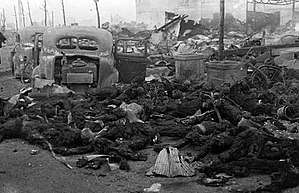
800,000 Japanese civilians[211] and over 2 million Japanese soldiers died during the war. According to a report compiled by the Relief Bureau of the Japanese Ministry of Health and Welfare in March 1964, combined Japanese Army and Navy deaths during the war (1937–45) numbered approximately 2,121,000 men, mostly against either the Americans (1.1+ million) in places such as the Solomons, Japan, Taiwan, the Central Pacific, and the Philippines, or against various Chinese factions (500,000+), predominantly the NRA and CCP, during the war on the Chinese mainland, the Chinese resistance movement in Manchuria and Burma campaign. The losses were broken down as follows:[212]
Key: Location, Army dead, Navy dead, (Total dead)
Japan Proper: 58,100, 45,800, (103,900)
Bonin Islands: 2,700, 12,500, (15,200)
Okinawa: 67,900, 21,500, (89,400)
Formosa (Taiwan): 28,500, 10,600, (39,100)
Korea: 19,600, 6,900, (26,500)
Sakhalin, the Aleutian, and Kuril Islands: 8,200, 3,200, (11,400)
Manchuria: 45,900, 800, (46,700)
China (inc. Hong Kong): 435,600, 20,100, (455,700)
Siberia: 52,300, 400, (52,700)
Central Pacific: 95,800, 151,400, (247,200)
Philippines: 377,500, 121,100, (498,600)
French Indochina: 7,900, 4,500, (12,400)
Thailand: 6,900, 100, (7,000)
Burma (inc. India): 163,000, 1,500, (164,500)
Malaya & Singapore: 8,500, 2,900, (11,400)
Andaman & Nicobar Islands: 900, 1,500, (2,400)
Sumatra: 2,700, 500, (3,200)
Java: 2,700, 3,800, (6,500)
Lesser Sundas: 51,800, 1,200, (53,000)
Borneo: 11,300, 6,700, (18,000)
Celebes: 1,500, 4,000, (5,500)
Moluccas: 2,600, 1,800, (4,400)
New Guinea: 112,400, 15,200, (127,600)
Bismarck Archipelago: 19,700, 10,800, (30,500)
Solomon Islands: 63,200, 25,000, (88,200)
Total: 1,647,200, 473,800, (2,121,000)
The IJN lost over 341 warships, including 11 battleships, 25 aircraft carriers, 39 cruisers, 135 destroyers, and 131 submarines, almost entirely in action against the United States Navy. The IJN and IJA together lost some 45,125 aircraft.[213]
Japan's ally Germany lost 10 submarines and four auxiliary cruisers (Thor, Michel, Pinguin, and Kormoran) in the Indian and Pacific oceans.[196] These four alone sank 420,467 gross tons of Allied shipping.
War crimes
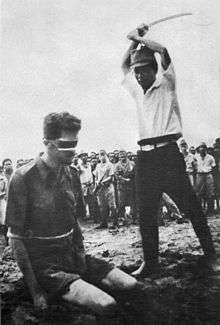
On 7 December 1941, 2,403 non-combatants (2,335 neutral military personnel and 68 civilians) were killed and 1,247 wounded during the Japanese surprise attack on Pearl Harbor. Because the attack happened without a declaration of war or explicit warning, it was judged by the Tokyo Trials to be a war crime.[214][215]
During the Pacific War, Japanese soldiers killed millions of non-combatants, including prisoners of war, from surrounding nations.[216] At least 20 million Chinese died during the Second Sino-Japanese War (1937–1945).[217][218]
Unit 731 was one example of wartime atrocities committed on a civilian population during World War II, where experiments were performed on thousands of Chinese and Korean civilians as well as Allied prisoners of war. In military campaigns, the Imperial Japanese Army used biological weapons and chemical weapons on the Chinese, killing around 400,000 civilians.[219] The Nanking Massacre is another example of atrocity committed by Japanese soldiers on a civilian population.[220]

According to the findings of the Tokyo Tribunal, the death rate of Western prisoners was 27%, some seven times that of POWs under the Germans and Italians.[163] The most notorious use of forced labour was in the construction of the Burma–Thailand "Death Railway." Around 1,536 U.S. civilians were killed or otherwise died of abuse and mistreatment in Japanese internment camps in the Far East; in comparison, 883 U.S. civilians died in German internment camps in Europe.[221]
A widely publicised example of institutionalised sexual slavery are "comfort women", a euphemism for the 200,000 women, mostly from Korea and China, who served in the Imperial Japanese Army's camps during World War II. Some 35 Dutch comfort women brought a successful case before the Batavia Military Tribunal in 1948.[222] In 1993, Chief Cabinet Secretary Yōhei Kōno said that women were coerced into brothels run by Japan's wartime military. Other Japanese leaders have apologized, including former Prime Minister Junichiro Koizumi in 2001. In 2007, then-Prime Minister Shinzō Abe asserted: "The fact is, there is no evidence to prove there was coercion."[223]
The Three Alls Policy (Sankō Sakusen) was a Japanese scorched earth policy adopted in China, the three alls being: "Kill All, Burn All and Loot All". Initiated in 1940 by Ryūkichi Tanaka, the Sankō Sakusen was implemented in full scale in 1942 in north China by Yasuji Okamura. According to historian Mitsuyoshi Himeta, the scorched earth campaign was responsible for the deaths of "more than 2.7 million" Chinese civilians.[224]
The collection of skulls and other remains of Japanese soldiers by Allied soldiers was shown by several studies to have been widespread enough to be commented upon by Allied military authorities and US wartime press.[225]
Following the surrender of Japan, the International Military Tribunal for the Far East took place in Ichigaya, Tokyo from 29 April 1946 to 12 November 1948 to try those accused of the most serious war crimes. Meanwhile, military tribunals were also held by the returning powers throughout Asia and the Pacific for lesser figures.[226][227]
See also
- European theatre of World War II
- Japanese holdouts
- Operation Downfall
- Pacific War campaigns
- Post–World War II economic expansion
- Timeline WW II – Pacific Theater
- Yasukuni Shrine
Notes
- ↑ At war since 1937
- ↑ Complete list of nations that fought on the Allied side in the Pacific War: China, the United States, the United Kingdom (including the Fiji Islands, the Straits Settlements and other colonial forces), Tonga (a British protectorate), Australia (including the Territory of New Guinea), the Commonwealth of the Philippines (a United States protectorate), British India, the Netherlands (including Dutch East Indies colonial forces), the Soviet Union, New Zealand, Canada, Mexico, and Mongolia. Free French Naval Forces contributed several warships, such as the Le Triomphant. After the Liberation of France, the French battleship Richelieu was sent to the Pacific. From 1943, the commando group Corps Léger d'Intervention took part in resistance operations in Indochina. French Indochinese forces faced Japanese forces in a coup in 1945. The commando corps continued to operate after the coup until liberation.
Guerrilla organizations that fought for the Allies include the Chinese Eighth Route Army and New Fourth Army, the Hukbalahap, the Malayan Peoples' Anti-Japanese Army, the Manchurian Anti-Japanese Volunteer Armies, the Korean Liberation Army, the Free Thai Movement and the Việt Minh. - ↑ Complete list of nations and groups that fought on the Axis side in the Pacific War: Japan (including Thailand, the puppet government of Manchukuo, Mengjiang, Wang Jingwei regime, and other Chinese collaborationist governments and organizations, the State of Burma, the Provisional Government of Free India, the puppet Second Philippine Republic, and other states in the Greater East Asia Co-Prosperity Sphere). The Vichy French allowed the Japanese to use bases in French Indochina beginning in 1941 following invasion. In addition, Germany and Italy both contributed small naval forces.
- ↑ Strength of the US Military in Asia and the Pacific as of war's end: Army: 1,770,036,[3] Navy (excluding Coast Guard and Marines): 1,366,716,[4] and Marine Corps: 484,631.[5] These figures do not include the Coast Guard or naval personnel in the China-Burma-India theater.[6]
- ↑ These numbers do not include the Royal Netherlands Navy.
- ↑ 111,914 battle deaths (including 13,395 who died as POWs and 5,707 who died of wounds), 49,000+ non-battle deaths,[17] 248,316 wounded, 16,358 captured and returned[18][19]
- ↑ Over 17 million Chinese civilian deaths (1937–45);[20] around 4 million civilian deaths from the Dutch East Indies;[21] 1–2 million Indochinese civilians;[22] around 3 million[23] Indian civilian deaths in the Bengal famine of 1943; 0.5 to 1 million[24] Filipino civilian deaths; 250,000[25] to 1,000,000[26] Burmese civilian deaths; 50,000[27] East Timorese civilian deaths; and hundreds of thousands of Malayan, Pacific and other civilian deaths[21]
- ↑ 2,133,915 Japanese military deaths 1937–45,[28] 1.18 million Chinese collaborator casualties 1937–45 (432,000 dead),[29] 22,000 Burmese casualties, 5,600 Thai troops killed,[30] and 2,615 Indian National Army (Azad Hind) killed/missing[31]
- ↑ 460,000 Japanese civilian deaths (338,000 in the bombings of Japan,[32] 100,000 in the Battle of Okinawa, 22,000 in the Battle of Saipan), 543,000 Korean civilian deaths (mostly due to Japanese forced labor projects),[33] 2,000–8,000 Thai civilian deaths[34]
- ↑ "For fifty-three long months, beginning in July 1937, China stood alone, single-handedly fighting an undeclared war against Japan. On 9 December 1941, after Japan's surprise attack on Pearl Harbor, China finally declared war against Japan. What had been for so long a war between two countries now became part of a much wider Pacific conflict."[37]
- ↑
- ↑ The Neutrality Patrol had US destroyers fighting at sea, but no state of war had been declared by Congress.
- ↑ The US thereby reversed its opposition to unrestricted submarine warfare. After the war, when moralistic doubts about Hiroshima and other raids on civilian targets were loudly voiced, no one criticized Roosevelt's submarine policy. (Two German admirals, Erich Raeder and Karl Dönitz, faced charges at the Nuremberg War Crimes Trials of violating international law through unrestricted submarine warfare; the court acquitted them after they proved that Allied merchant ships were legitimate military targets under the rules in force at the time.)
- ↑ Chihaya went on to note that when the IJN belatedly improved its ASW methods, the US submarine force responded by increasing Japanese losses.[134]
References
Citations
- ↑ A Decade of American Foreign Policy 1941–1949 Interim Meeting of Foreign Ministers, Moscow Archived 8 November 2017 at the Wayback Machine.. Retrieved 30 September 2009.
- ↑ Hastings p. 205
- ↑ Coakley and Leighton (1989). Global Logistics and Strategy 1943–1945 p. 836
- ↑ US Navy Personnel in World War II Service and Casualty Statistics, Naval History and Heritage Command Table 9.
- ↑ King, Ernest J. (1945). Third Report to the Secretary of the Navy p. 221
- ↑ US Navy Personnel in World War II Service and Casualty Statistics, Naval History and Heritage Command Footnote 2.
- 1 2 Hastings, p. 10.
- ↑ Beevor: The Second World War p. 776. Total involved in Manchuria
- ↑ "Chapter 10: Loss of the Netherlands East Indies". The Army Air Forces in World War II: Vol. 1 – Plans & Early Operations. HyperWar. Retrieved 31 August 2010.
- ↑ Cook (1992). Japan at War: an Oral History. New Press. ISBN 978-1-56584-039-3. p. 403. Japanese strength is given at 4,335,500 in the Home Islands and 3,527,000 abroad.
- ↑ Harrison p. 29 Retrieved 10 March 2016
- ↑ Australia-Japan Research Project, "Dispositions and Deaths" Retrieved 10 March 2016
- ↑ Meyer, Milton Walter (1997). Asia: A Concise History. Lanham: Rowman & Littlefield. p. 309. ISBN 9780847680634.
- ↑ Jowett, pp. 72
- ↑ Hsu Long-hsuen "History of the Sino-Japanese war (1937–1945)" Taipei 1972
- ↑ Clodfelter, Michael "Warfare and Armed Conflicts: A Statistical Reference", Vol. 2, pp. 956.
- ↑ C. E. Albertson, "Beneath the Southern Cross" p. xv
- 1 2 "United States Dept. of the Army, Army Battle Casualties and Non Battle Deaths in World War II". Cgsc.cdmhost.com. Retrieved 15 June 2011.
- ↑ Michael Clodfelter. Warfare and Armed Conflicts – A Statistical Reference to Casualty and Other Figures, 1500–2000. 2nd Ed. 2002 ISBN 0-7864-1204-6. p. 585.
- ↑ "Chinese People Contribute to WWII". Retrieved 23 April 2009.
- 1 2 Dower, John William (1987), War Without Mercy: Race and Power in the Pacific War. Pantheon
- ↑ "Vietnam needs to remember famine of 1945". Mailman.anu.edu.au. Retrieved 31 October 2010.
- ↑ Amartya Sen (1981). Poverty and Famines: An Essay on Entitlement and Deprivation. London: Oxford University Press. p. 203. ISBN 9780195649543.
- ↑ Werner Gruhl, Imperial Japan's World War Two, 1931–1945 Transaction 2007 ISBN 978-0-7658-0352-8. pp. 143–44.
- ↑ Michael Clodfelter. Warfare and Armed Conflicts: A Statistical Reference to Casualty and Other Figures, 1500–2000. 2nd ed. 2002 ISBN 0-7864-1204-6. p. 556
- 1 2 McLynn, The Burma Campaign: Disaster into Triumph, 1942–1945, p. 1.
- ↑ Ruas, Óscar Vasconcelos, "Relatório 1946–47", AHU
- ↑ Bren, John (3 June 2005) "Yasukuni Shrine: Ritual and Memory" Japan Focus. Retrieved on 5 June 2009.
- ↑ R. J. Rummel. China's Bloody Century. Transaction 1991 ISBN 0-88738-417-X. Table 5A
- ↑ Eiji Murashima, "The Commemorative Character of Thai Historiography: The 1942–43 Thai Military Campaign in the Shan States Depicted as a Story of National Salvation and the Restoration of Thai Independence" Modern Asian Studies, v40, n4 (2006) pp. 1053–96, p. 1057n:
- ↑ Michael Clodfelter. Warfare and Armed Conflicts – A Statistical Reference to Casualty and Other Figures, 1500–2000. 2nd Ed. 2002 ISBN 0-7864-1204-6. p. 556.
- ↑ Statistics of Democide: Chapter 13: Death By American Bombing, RJ Rummel, University of Hawaii.
- ↑ Werner Gruhl, Imperial Japan's World War Two, 1931–1945 Transaction 2007 ISBN 978-0-7658-0352-8 p. 19
- ↑ E. Bruce Reynolds, "Aftermath of Alliance: The Wartime Legacy in Thai-Japanese Relations", Journal of Southeast Asian Studies, v21, n1, March 1990, pp. 66–87. "An OSS document (XL 30948, RG 226, USNA) quotes Thai Ministry of Interior figures of 8,711 air raids deaths in 1944–45 and damage to more than 10,000 buildings, most of them totally destroyed. However, an account by M. R. Seni Pramoj (a typescript entitled 'The Negotiations Leading to the Cessation of a State of War with Great Britain' and filed under Papers on World War II, at the Thailand Information Center, Chulalongkorn University, p. 12) indicates that only about 2,000 Thai died in air raids."
- ↑ Williamson Murray, Allan R. Millett, A War to be Won: Fighting the Second World War, Harvard University Press, 2001, p. 143
- ↑ Roy M. MacLeod, Science and the Pacific War: Science and Survival in the Pacific, 1939–1945, Kluwer Academic Publishing, p. 1, 1999
- ↑ Hsi-sheng Ch'i, in James C. Hsiung and Steven I. Levine, China's Bitter Victory: The War with Japan 1937–1945, M.E. Sharpe, 1992, p. 157.
- ↑ Youli Sun, China and the Origins of the Pacific War, 1931–41, Palgrave MacMillan, p. 11
- ↑ Drea 1998, p. 26.
- ↑ John Costello, The Pacific War: 1941–1945, Harper Perennial, 1982
- ↑ Japan Economic Foundation, Journal of Japanese Trade & Industry, Volume 16, 1997
- ↑ Takemae 2003, p. 516.
- ↑ "MacArthur orders end of Shinto as Japanese state religion". HISTORY.com. Retrieved 1 December 2015.
- ↑ Jansen 2002, p. 626.
- ↑ "The Effects of Strategic Bombing on Japan's War Economy", United States Strategic Bombing Survey, Washington December 1946, Table B-2. From 1942 to 1945, 92,511,000 yen was spent on the IJA and 59,766,000 yen was spent on the IJN.
- ↑ "WW2 People's War – Timeline". BBC. Archived from the original on 19 March 2011. Retrieved 31 October 2010.
- ↑ "Map of the Pacific Theater". Archived from the original on 9 January 2009. Retrieved 31 October 2010.
- ↑ Harmsen, Peter (2013). Shanghai 1937: Stalingrad on the Yangtze. Casemate; First edition. ISBN 978-1612001678.
- ↑ Harmsen, Peter (2015). Nanjing 1937: Battle for a Doomed City. Casemate. ISBN 978-1612002842.
- ↑ Olsen, Lance (2012). Taierzhuang 1938 – Stalingrad 1942: Insight into a blind spot of WW2 Series. Clear Mind Publishing. ISBN 9780983843573.
- ↑ MacKinnon, Stephen (2008). Wuhan, 1938: War, Refugees, and the Making of Modern China. University of California Press. ISBN 978-0520254459.
- ↑ Edward J. Drea, Nomonhan: Japanese-Soviet Tactical Combat, 1939 (2005)
- ↑ Boyd, Carl. Hitler's Japanese confidant: General Ōshima Hiroshi and MAGIC intelligence, 1941–1945 (1993)
- ↑ Hsiao-ting Lin (2010). James C. Hsiung and Steven I. Levine, eds. Modern China's Ethnic Frontiers: A Journey to the West. Volume 67 of Routledge Studies in the Modern History of Asia (illustrated ed.). Taylor & Francis. p. 55. ISBN 0-415-58264-4. Retrieved 28 June 2010.
- ↑ Chinese-Soviet Relations, 1937–1945; Garver, John W.; p. 120.
- ↑ Jansen 2002, p. 636.
- ↑ Fairbank, John King; Goldman, Merle (1994). China: A New History. Harvard University Press. p. 320. ISBN 0-674-11673-9.
- ↑ Lind Jennifer M. (2010). "Sorry States: Apologies in International Politics". Cornell University Press, p.28. ISBN 0-8014-7628-3
- ↑ R.J. Rummel (31 August 2007). China's Bloody Century: Genocide and Mass Murder Since 1900. Transaction Publishers.
- ↑ "Japans desperate gamble". Aberdeen Journal. 18 November 1940. Retrieved 6 May 2015 – via British Newspaper Archive. (Subscription required (help)).
- ↑ Kokushi Daijiten ("Historical Dictionary"), 1980
- ↑ Cited by Christopher Barnard, 2003, Language, Ideology and Japanese History Textbooks, London & New York, Routledge Curzon, p. 85.
- ↑ Stille 2014, p. 23.
- 1 2 3 Peattie & Evans, Kaigun
- ↑ Willmott, Barrier and the Javelin (Annapolis: Naval Institute Press, 1983).
- 1 2 Stille 2014, p. 28.
- 1 2 Boog et al (2006) "Germany and the Second World War: The Global War", p. 175
- 1 2 Evans & Peattie 1997, p. 488.
- ↑ Khan, David (1996). The Codebreakers, The Story of Secret Writing (2 ed.). New York: Scribner. ISBN 0-684-83130-9.
- 1 2 Parillo, Mark P. Japanese Merchant Marine in World War II. (United States Naval Institute Press, 1993).
- ↑ "Declaration of War with Japan". United States Congress. 8 December 1941. Archived from the original on 26 September 2011.
- ↑ "Prime Minister's Declaration". UK Parliament. 8 December 1941. Retrieved 3 May 2015.
- ↑ "Canada Declares War on Japan". Inter-Allied Review. 15 December 1941. Retrieved 8 April 2015 – via Pearl Harbor History Associates, Inc.
- ↑ "The Kingdom of the Netherlands Declares War with Japan". Inter-Allied Review. 15 December 1941. Retrieved 3 October 2009 – via Pearl Harbor History Associates Inc.
- ↑ "China's Declaration of War Against Japan, Germany and Italy". Contemporary China. jewishvirtuallibrary.org. 1 (15). 15 December 1941. Retrieved 10 September 2010.
- ↑ "Australia Declares War on Japan". Inter-Allied Review. 15 December 1941. Retrieved 3 October 2009 – via Pearl Harbor History Associates Inc.
- ↑ Peattie 2007, pp. 168–169.
- ↑ Brecher, Michael; Wilkenfeld, Jonathan (1997). A Study of Crisis. University of Michigan Press. p. 407. ISBN 978-0472108060.
- ↑ Barber, Andrew (2010). Penang At War : A History of Penang During and Between the First and Second World Wars 1914–1945. AB&B. ISBN 9789834337230.
- ↑ "Remembering 1942, The fall of Singapore, 15 February 1942". Awm.gov.au. Retrieved 31 October 2010.
- ↑ Klemen, L (1999–2000). "The capture of Bali Island, February 1942". Forgotten Campaign: The Dutch East Indies Campaign 1941–1942.
- ↑ Klemen, L (1999–2000). "The Japanese Invasion of Dutch West Timor Island, February 1942". Forgotten Campaign: The Dutch East Indies Campaign 1941–1942. See Battle of Timor.
- 1 2 Peattie 2007, pp. 170–172.
- ↑ Klemen, L (1999–2000). "The Java Sea Battle, February 1942". Forgotten Campaign: The Dutch East Indies Campaign 1941–1942.
- ↑ Klemen, L (1999–2000). "The conquest of Java Island, March 1942". Forgotten Campaign: The Dutch East Indies Campaign 1941–1942.
- ↑ Womack, Tom (1999–2000). "An Abandoned Army – The KNIL and The Japanese Invasion of Northern Dutch Sumatra". Dutch East Indies Campaign website.
- ↑ Peattie 2007, p. 172.
- ↑ Hsu & Chang 1971, pp. 377.
- 1 2 3 Blair, Silent Victory
- ↑ "In office – John Curtin – Australia's PMs – Australia's Prime Ministers". Primeministers.naa.gov.au. Retrieved 20 April 2013.
- ↑ Cited in Frank Crowley (1973) Vol 2, p. 51
- ↑ "Remembering the war in New Guinea – Rabaul". Ajrp.awm.gov.au. Retrieved 20 April 2013.
- ↑ "Remembering the war in New Guinea – Were the Japanese going to invade?". Ajrp.awm.gov.au. 19 February 1942. Retrieved 20 April 2013.
- ↑ "Midget Submarines history at". Home.st.net.au. Retrieved 29 April 2010.
- ↑ Stille 2014, p. 30.
- 1 2 3 4 5 Stille 2014, p. 31.
- ↑ Jansen 2002, p. 648.
- 1 2 Willmott 1983, p. 118.
- ↑ Stille 2014, pp. 31-32.
- 1 2 3 4 5 Stille 2014, p. 32.
- ↑ Stille 2014, pp. 32-34.
- 1 2 3 4 5 Stille 2014, p. 34.
- ↑ Evans & Peattie 1997, p. 489.
- ↑ Parshall & Tully 2005, p. 33.
- ↑ Parshall & Tully 2005, pp. 19-38.
- 1 2 Stille 2014, p. 35.
- ↑ Willmott, Barrier and the Javelin (Annapolis, 1983).
- 1 2 Stille 2014, p. 36.
- 1 2 3 Stille 2014, p. 37.
- 1 2 3 Stille 2014, p. 38.
- ↑ Parshall & Tully 2005, pp. 417.
- ↑ Willmott 2002, p. 96.
- ↑ Willmott 2002, p. 109.
- ↑ Evans & Peattie 1997, p. 490.
- ↑ Ch'i 1992, p. 158.
- ↑ Schoppa, R. Keith (2011). In a Sea of Bitterness, Refugees during the Sino-Japanese War. Harvard University Press. p. 28. ISBN 9780674059887.
- ↑ Yuki Tanaka, Hidden Horrors, Westviewpres, 1996, p.138
- ↑ Chevrier & Chomiczewski & Garrigue 2004, p. 19.
- ↑ Croddy & Wirtz 2005, p. 171.
- 1 2 "Chinese Victory: Changteh is Lost and Won in Battle Called Most Decisive in Three Years". LIFE: 45. 21 February 1944.
- ↑ Philip J. Jaffe (1943). Amerasia, Volume 7. Amerasia, inc.
|access-date=requires|url=(help) - ↑ Agar, Jon Science in the 20th Century and Beyond, p. 281.
- ↑ Allen, Louis (1984). Burma: The longest War. Dent Publishing. pp. 112–116. ISBN 0-460-02474-4.
- ↑ Evans & Peattie 1997, p. 491.
- ↑ Theodore Roscoe, United States Submarine Operations in World War II (US Naval Institute Press, 1949).
- ↑ Prange et al. Pearl Harbor Papers
- 1 2 Roscoe, Theodore. Pig Boats (Bantam Books, 1958); Blair, Silent Victory, pp. 991–992.
- ↑ "Boats," www.dutchsubmarines.com
- ↑ Larry Kimmett and Margaret Regis, U.S. Submarines in World War II
- ↑ TIME, Monday, 23 February 1942 (23 February 1942). "World Battlefronts: Dutchman's Chance". Time.
- ↑ David Stevens. Japanese submarine operations against Australia 1942–1944. Retrieved 18 June 2007.
- ↑ Carl Boyd, "The Japanese Submarine Force and the Legacy of Strategic and Operational Doctrine Developed Between the World Wars", in Larry Addington ed. Selected Papers from the Citadel Conference on War and Diplomacy: 1978 (Charleston, 1979) 27–40; Clark G. Reynolds, Command of the Sea: The History and Strategy of Maritime Empires (1974) 512.
- ↑ Farago, Ladislas. Broken Seal.
- ↑ Chihaya Masataka, in Pearl Harbor Papers, p. 323.
- ↑ Blair, Silent Victory, pp. 359–360, 551–552, 816.
- ↑ RD Designs (7 December 1941). "Sinkings By Boat". Pigboats.com. Retrieved 31 October 2010.
- ↑ "Japanese Naval and Merchant Vessels Sunk During World War II By All U.S. Submarines". Valoratsea.com. Archived from the original on 15 September 2012. Retrieved 31 October 2010.
- ↑ Roscoe, op. cit.
- ↑ Blair, p. 877.
- ↑ The Joint Army-Navy Assessment Committee (February 1947), Transcribed and formatted for HTML by Larry Jewell & Patrick Clancey, ed., Japanese Naval and Merchant Shipping Losses During World War II by All Causes NAVEXOS P-468, Hyperwar project ed. Patrick Clancey
- ↑ "Operation Ichi-Go". Archived from the original on 17 November 2015. Retrieved 6 December 2015.
- 1 2 Davison, John The Pacific War: Day By Day, pp. 37, 106
- ↑ 新聞記者が語りつぐ戦争 16 中国慰霊 読売新聞社 (1983/2) p. 187.
- ↑ China at War: An Encyclopedia. Ed. Li Xiaobing. United States of America: ABC-CLIO. 2012. ISBN 978-1-59884-415-3. Retrieved 21 May 2012. p. 163.
- ↑ Bond, Tachikawa, p. 122.
- ↑ Stevens, p. 70.
- ↑ Y'Blood 1981, p. 14.
- 1 2 Stille 2014, p. 46.
- 1 2 3 Stille 2014, p. 47.
- 1 2 Y'Blood 1981, p. 15.
- ↑ Blair, Clay, Jr. Silent Victory (New York: Bantam, 1976).
- ↑ Morison, S. E. U.S. Navy in World War Two.
- ↑ Peattie 2007, pp. 188–189.
- 1 2 3 4 Stille 2014, p. 49.
- 1 2 3 Stille 2014, p. 50.
- ↑ Stille 2014, p. 50; Willmott 2005, p. 255.
- ↑ Klemen, L. "201st Mexican Fighter Squadron". The Netherlands East Indies 1941–1942. 201st Mexican Fighter Squadron
- 1 2 "Creating military power: the sources of military effectiveness". Risa Brooks, Elizabeth A. Stanley (2007). Stanford University Press. p. 41. ISBN 0-8047-5399-7
- ↑ Powers, D. (2011): Japan: No Surrender in World War Two BBC History (17 February 2011).
- ↑ Robert S. Burrell, "Breaking the Cycle of Iwo Jima Mythology: A Strategic Study of Operation Detachment," Journal of Military History Volume 68, Number 4, October 2004, pp. 1143–1186 and rebuttal in Project MUSE
- ↑ Hsu & Chang 1971, p. 457.
- ↑ Slim, William (1956). Defeat into Victory. Cassell. pp. 468–469. ISBN 0-552-08757-2.
- 1 2 3 "Japanese prisoners of war". Philip Towle, Margaret Kosuge, Yōichi Kibata (2000). Continuum International Publishing Group. pp. 47–48. ISBN 1-85285-192-9.
- ↑ Grey, Jeffrey (1999). A Military History of Australia. Cambridge, England: Cambridge University Press. ISBN 0-521-64483-6. . pp. 184–186.
- 1 2 Wilson, Dick. When Tigers Fight. New York, NY: The Viking Press, 1982. p. 248
- 1 2 Hsu & Chang 1971, pp. 452–457.
- ↑ "National Revolutionary Army Order of Battle for the Battle of West Hunan". China Whampoa Academy Net. 11 September 2007 <http://www.hoplite.cn/Templates/hpjh0106.htm>.
- ↑ Joseph H. Alexander, The final campaign: Marines in the victory on Okinawa (1996) short official history online
- ↑ Hiromichi Yahara, The Battle For Okinawa (1997), Japanese perspective excerpt and text search
- ↑ Skates, James. Invasion of Japan.
- ↑ "Potsdam Declaration: Proclamation Defining Terms for Japanese Surrender Issued, at Potsdam, July 26, 1945". National Science Digital Library.
- ↑ "PBS: Statement By The President". Retrieved 15 August 2015.
- 1 2 Professor Duncan Anderson, 2005,"Nuclear Power: The End of the War Against Japan" (World War Two, BBC History website) Access date: 11 September 2007.
- ↑ See, for example, Alperowitz, G., The Decision to Use the Atomic Bomb (1995; New York, Knopf; ISBN 0-679-44331-2) for this argument.
- ↑ Frank, Richard B. (2007). Tsuyoshi Hasegawa, ed. The End of the Pacific War: Reappraisals. Stanford University Press. p. 89. ISBN 978-0-8047-5427-9.
- ↑ Battlefield S4/E3 – The Battle of Manchuria – The Forgotten Victory. YouTube. 10 October 2012. Retrieved 1 December 2015.
- ↑ Raymond L. Garthoff. The Soviet Manchurian Campaign, August 1945. Military Affairs, Vol. 33, No. 2 (Oct. 1969), pp. 312–336
- ↑ Toland, John (2003). The Rising Sun: the Decline and Fall of the Japanese Empire. New York: Random House. p. 806. ISBN 0-8129-6858-1.
- ↑ Sadao Asada. "The Shock of the Atomic Bomb and Japan's Decision to Surrender: A Reconsideration". The Pacific Historical Review, Vol. 67, No. 4 (Nov. 1998), pp. 477–512.
- ↑ Patrick Clancey. "The Voice of the Crane: The Imperial Rescript of 15Aug45". ibiblio. University of North Carolina at Chapel Hill. Retrieved 27 September 2012.
- ↑ "Chronology of Japanese Holdouts". Wanpela.com. Retrieved 31 October 2010.
- ↑ Clofelter, p. 585
- ↑ Hara, p. 299
- ↑ http://www.navsource.org Retrieved 25 July 2015; www.uboat.net Retrieved 25 July 2015; Major British Warship Losses in World War II. Retrieved 25 July 2015.
- ↑ Gruhl, Werner (2007). Imperial Japan's World War Two. New Brunswick: Transaction Publishers. p. 65. ISBN 9780765803528.
- ↑ Gruhl, p. 143-144
- ↑ Clodfelter, p. 956
- ↑ Meng Guoxiang & Zhang Qinyuan, 1995. "关于抗日战争中我国军民伤亡数字问题".
- ↑ Ho Ping-ti. Studies on the Population of China, 1368–1953. Cambridge: Harvard University Press, 1959.
- ↑ Clodfelter, p. 956
- ↑ Himeta, Mitsuyoshi (1995). 日本軍による『三光政策・三光作戦をめぐって [Concerning the Three Alls Strategy/Three Alls Policy By the Japanese Forces]. Iwanami Bukkuretto. p. 43. ISBN 978-4-00-003317-6.
- ↑ Corfield, Justin & Robin (2012). The Fall of Singapore. Singapore: Talisman Books. ISBN 978-981-07-0984-6. Page 743.
- ↑ Nesbit, The Battle for Burma pp. 240
- ↑ Banham, Tony (2005). Not the Slightest Chance: The Defence of Hong Kong, 1941. Hong Kong: Hong Kong University Press. Page 317.
- ↑ Kevin Blackburn, Karl Hack. "Forgotten Captives in Japanese-Occupied Asia". 2007. p. 4. British Empire POWs are given a death rate of 25%.
- ↑ Long (1963), pp. 633–34
- ↑ "Honouring NZ's Pacific War dead". Beehive. 15 August 2005. Retrieved 31 October 2010.
- ↑ (12,031 killed and 24,425 wounded in the 1945 Soviet invasion of Manchuria, 10,495 killed and 21,456 wounded in the 1938 Battle of Lake Khasan and 1939 Battles of Khalkhin Gol), 205 advisors killed in China.
- ↑ Per "Soviet Losses in the Khalkhin Gol Battle", losses at Khalkin Gol were: 30 BT-7s, 27 BT-7RTs,2 BT-7As, 127 BT-5s, 30 BT-5RTs, 8 T-26s, 10 KhT-26S, 2 KhT-130S, 17 T-37s, and 133 BA-6/BA-10 armored cars. This does not include tanks that only sustained light to moderate damage, or ones lost due to mechanical failure.
- ↑ Japanese Monograph no. 154: Record of Operations against Soviet Russia, Eastern Front August 1945 Page 39.
- ↑ Russell, Richard A., Project Hula: Secret Soviet-American Cooperation in the War Against Japan, Washington, D.C.: Naval Historical Center, 1997, ISBN 0-945274-35-1, pp. 30–31.
- ↑ Coox, Alvin (July 1973). "The Lake Khasan Affair of 1938: Overview and Lessons". Soviet Studies. 25 (1): 53.
- ↑ "Russia and USSR in Wars of the 20th Century". И.И.Ивлев. Archived from the original on 5 May 2008. Retrieved 11 July 2008.
- ↑ "WORLD WAR II: THE DEFENSIVE PHASE", US Army Center Of Military History, p. 87
- ↑ Kevin Blackburn, Karl Hack. "Forgotten Captives in Japanese-Occupied Asia". 2007. p. 4.
- ↑ Allied War Losses. uboat.net. Retrieved Feb. 24 2018.
- ↑ United Nations, Economic and Social Council, Report of the Working Group for Asia and the Far East, Supp. 10. 1947 pp. 13–14
- ↑ Werner Gruhl, Imperial Japan's World War Two, 1931–1945 Transaction 2007 ISBN 978-0-7658-0352-8, pp 19, 143
- ↑ Marr, David G. (1995). Vietnam 1945: The Quest for Power. University of California Press. Page 61.
- ↑ Ishikida, Miki (2005). Toward Peace: War Responsibility, Postwar Compensation, and Peace Movements and Education in Japan. iUniverse, Inc. (July 13, 2005). p. 30. ISBN 978-0595350636. Retrieved March 4, 2016.
- ↑ "Figures were compiled by the Relief Bureau of the Ministry of Health and Welfare in March 1964". Australia-Japan Research Project. Retrieved 2016-03-10.
- ↑ Hara p. 297-299
- ↑ Yuma Totani (1 April 2009). The Tokyo War Crimes Trial: The Pursuit of Justice in the Wake of World War II. Harvard University Asia Center. p. 57.
- ↑ Stephen C. McCaffrey (22 September 2004). Understanding International Law. AuthorHouse. pp. 210–229.
- ↑ "Rummel, R.J. '''Statistics of Democide: Genocide and Mass Murder since 1900''' Chapter 3. LIT Verlag Münster-Hamburg-Berlin-Wien-London-Zürich (1999)". Hawaii.edu. Retrieved 31 October 2010.
- ↑ "BBC – History – World Wars: Nuclear Power: The End of the War Against Japan". bbc.co.uk. Retrieved 1 December 2015.
- ↑ "Remember role in ending fascist war". Retrieved 6 December 2015.
- ↑ Christopher Hudson (2 March 2007). "Doctors of Depravity". Daily Mail.
- ↑ Chapel, Joseph (2004). "Denial of the Holocaust and the Rape of Nanking".
- ↑ U.S. Prisoners of War and Civilian American Citizens Captured and Interned by Japan in World War II: The Issue of Compensation by Japan.
- ↑ de Brouwer, Anne-Marie (2005). Supranational Criminal Prosecution of Sexual Violence. Intersentia. p. 8. ISBN 90-5095-533-9.
- ↑ "No government coercion in war's sex slavery: Abe", The Japan Times, 2 March 2007.
- ↑ Himeta, Mitsuyoshi (姫田光義) (日本軍による『三光政策・三光作戦をめぐって』) (Concerning the Three Alls Strategy/Three Alls Policy By the Japanese Forces), Iwanami Bukkuretto, 1996, Bix, Hirohito and the Making of Modern Japan, 2000.
- ↑ "Simon Harrison, Dark Trophies: hunting and the enemy body in modern war, Berghahn Booksl, 2012
- ↑ Dennis et al. 2008, pp. 576–577.
- ↑ McGibbon 2000, pp. 580–581.
Sources
- Bergerud, Eric M. (2000). Fire in the Sky: The Air War in the South Pacific. Boulder, Colorado: Westview Press. ISBN 0-8133-3869-7.
- Blair Jr., Clay. Silent Victory. Philadelphia: Lippincott, 1975 (submarine war).
- Bond, Brian; Tachikawa, Kyoichi (2004). British and Japanese Military Leadership in the Far Eastern War, 1941–1945 Volume 17 of Military History and Policy Series. Routledge. ISBN 9780714685557.
- Buell, Thomas. Master of Seapower: A Biography of Admiral Ernest J. King Naval Institute Press, 1976.
- Buell, Thomas. The Quiet Warrior: A Biography of Admiral Raymond Spruance. 1974.
- Ch'i, Hsi-Sheng (1992). "The Military Dimension, 1942–1945". In James C. Hsiung and Steven I. Levine. China's Bitter Victory: War with Japan, 1937–45. Armonk, NY: M. E. Sharpe. ISBN 978-1-56324-246-5.
- Channel 4 (UK). Hell in the Pacific (television documentary series). 2001.
- Cleaver, Thomas McKelvey (2018). Tidal Wave: From Leyte Gulf to Tokyo Bay. Bloomsbury Publishing. ISBN 1-472-82546-2.
- Costello, John. The Pacific War. 1982, overview
- Craven, Wesley, and James Cate, eds. The Army Air Forces in World War II. Vol. 1, Plans and Early Operations, January 1939 to August 1942. University of Chicago Press, 1958. Official history; Vol. 4, The Pacific: Guadalcanal to Saipan, August 1942 to July 1944. 1950; Vol. 5, The Pacific: Matterhorn to Nagasaki. 1953.
- Cutler, Thomas (1994). The Battle of Leyte Gulf: 23–26 October 1944. Annapolis, Maryland, U.S.: Naval Institute Press. ISBN 1-55750-243-9.
- Degan, Patrick (2003). Fighting in World War II: The Battles Between American and Japanese Aircraft Carriers (New ed.). Jefferson, North Carolina: McFarland & Company Inc. ISBN 0-786-41451-0.
- Dennis, Peter; Grey, Jeffrey; Morris, Ewan; Prior, Robin; Bou, Jean (2008). The Oxford Companion to Australian Military History (Second ed.). Melbourne: Oxford University Press. ISBN 0195517849.
- Drea, Edward J. (1998). In the Service of the Emperor: Essays on the Imperial Japanese Army. Nebraska: University of Nebraska Press. ISBN 0-8032-1708-0.
- Dunnigan, James F., and Albert A. Nofi. The Pacific War Encyclopedia. Facts on File, 1998. 2 vols. 772p.
- Evans, David C; Peattie, Mark R (1997). Kaigun: strategy, tactics, and technology in the Imperial Japanese Navy, 1887–1941. Annapolis, Maryland: Naval Institute Press. ISBN 0-87021-192-7.
- Gailey, Harry A. (2011). The War in the Pacific: From Pearl Harbor to Tokyo Bay (reprint, 1995 ed.). Random House Publishing Group. ISBN 0-307-80204-3.
- Goldman, Stuart (2012). Nomonhan, 1939: The Red Army's Victory That Shaped World War II. Naval Institute Press. ISBN 1-61251-098-1.
- Gordon, David M. "The China-Japan War, 1931–1945" Journal of Military History (January 2006) v 70#1, pp 137–82. Historiographical overview of major books
- Seki, Eiji. (2006). Mrs. Ferguson's Tea-Set, Japan and the Second World War: The Global Consequences Following Germany's Sinking of the SS Automedon in 1940. London: Global Oriental. ISBN 978-1-905246-28-1 (cloth) (reprinted by University of Hawaii Press), Honolulu, 2007. previously announced as Sinking of the SS Automedon and the Role of the Japanese Navy: A New Interpretation.
- Hara, Tameichi (2011). Japanese Destroyer Captain. Annapolis, Maryland: Naval Institute Press. ISBN 978-1-59114-384-0.
- Harrison, Simon (2012). Dark Trophies. Hunting and the Enemy Body in Modern War. New York City: Berghahn Books. ISBN 978-0-85745-499-7.
- Hastings, Max (2008). Retribution. Knopf Doubleday Publishing Group. ISBN 978-0307263513.
- Saburo Hayashi and Alvin Coox. Kogun: The Japanese Army in the Pacific War. Quantico, Virginia: Marine Corps Assoc., 1959.
- Hopkins, William B. (2010). The Pacific War: The Strategy, Politics, and Players that Won the War. Zenith Press. ISBN 0-76033-975-9.
- Hsiung, James C. and Steven I. Levine, eds. China's Bitter Victory: The War with Japan, 1937–1945 M. E. Sharpe, 1992
- Hsi-sheng, Ch'i. Nationalist China at War: Military Defeats and Political Collapse, 1937–1945 University of Michigan Press, 1982
- Hsu Long-hsuen and Chang Ming-kai, History of The Sino-Japanese War (1937–1945), 2nd Ed., 1971. Translated by Wen Ha-hsiung, Chung Wu Publishing; 33, 140th Lane, Tung-hwa Street, Taipei, Taiwan Republic of China.
- Inoguchi, Rikihei, Tadashi Nakajima, and Robert Pineau. The Divine Wind. Ballantine, 1958. Kamikaze.
- James, D. Clayton. The Years of MacArthur. Vol. 2. Houghton Mifflin, 1972.
- Jansen, Marius B. (2002). The Making of Modern Japan. Cambridge, Mass: Harvard University Press. ISBN 0-674-00334-9.
- Jowett, Phillip (2005). Rays of the Rising Sun: Japan's Asian Allies 1931–1945 Volume 1: China and Manchukuo. Helion and Company Ltd. ISBN 1-874622-21-3.
- Kirby, S. Woodburn The War Against Japan. 4 vols. London: H.M.S.O., 1957–1965. Official Royal Navy history.
- L, Klemen (1999–2000). "Forgotten Campaign: The Dutch East Indies Campaign 1941–1942".
- Leary, William M. We Shall Return: MacArthur's Commanders and the Defeat of Japan. University Press of Kentucky, 1988.
- Long, Gavin (1963). The Final Campaigns. Australia in the War of 1939–1945. Series 1 – Army. Volume 7. Canberra: Australian War Memorial. OCLC 1297619.
- Lundstrom, John B. (2005). The First Team and the Guadalcanal Campaign: Naval Fighter Combat from August to November 1942 (New ed.). Annapolis, Maryland: US Naval Institute Press. ISBN 1-59114-472-8.
- McCarthy, Dudley (1959). South-West Pacific Area – First Year. Australia in the War of 1939–1945. Series 1 – Army. Volume 5. Canberra: Australian War Memorial. OCLC 3134247.
- McGibbon, Ian, ed. (2000). The Oxford Companion to New Zealand Military History. Auckland: Oxford University Press. ISBN 0-19-558376-0.
- Maurice Matloff and Edwin M. Snell Strategic Planning for Coalition Warfare 1941–1942, United States Army Center of Military History, Washington, D. C., 1990
- Stille, Mark (2014). The Imperial Japanese Navy in the Pacific War. Osprey Publishing. ISBN 1-47280-146-6.
- Stevens, Keith (2005). "A Token Operation: 204 Military Mission to China, 1941–1945". Asian Affairs. Risk Management Reference Center, EBSCOhost. 36 (1): 66, 74. doi:10.1080/03068370500039151.
- Miller, Edward S. (2007). War Plan Orange: The U.S. Strategy to Defeat Japan, 1897–1945. US Naval Institute Press. ISBN 1-59114-500-7.
- Peattie, Mark R (2007). Sunburst: The Rise of Japanese Naval Air Power, 1909–1941. Annapolis, Maryland: Naval Institute Press. ISBN 1-59114-664-X.
- Samuel Eliot Morison, History of United States Naval Operations in World War II. Vol. 3, The Rising Sun in the Pacific. Boston: Little, Brown, 1961; Vol. 4, Coral Sea, Midway and Submarine Actions. 1949; Vol. 5, The Struggle for Guadalcanal. 1949; Vol. 6, Breaking the Bismarcks Barrier. 1950; Vol. 7, Aleutians, Gilberts, and Marshalls. 1951; Vol. 8, New Guinea and the Marianas. 1962; Vol. 12, Leyte. 1958; vol. 13, The Liberation of the Philippines: Luzon, Mindanao, the Visayas. 1959; Vol. 14, Victory in the Pacific. 1961.
- Takemae, Eiji (2003). The Allied Occupation of Japan. Continuum Press. ISBN 0-82641-521-0.
- Masatake Okumiya, and Mitso Fuchida. Midway: The Battle That Doomed Japan. Naval Institute Press, 1955.
- Potter, E. B. and Chester W. Nimitz. Triumph in the Pacific. Prentice Hall, 1963. Naval battles
- Potter, E. B. Bull Halsey Naval Institute Press, 1985.
- Potter, E. B. Nimitz. Annapolis, Maryland: Naval Institute Press, 1976.
- Potter, John D.Yamamoto 1967.
- Prange, Gordon W. Donald Goldstein, and Katherine Dillon. At Dawn We Slept. Penguin, 1982. Pearl Harbor
- ——, et al. Miracle at Midway. Penguin, 1982.
- ——, et al. Pearl Harbor: The Verdict of History.
- Sarantakes, Nicholas Evan. Allies against the Rising Sun: The United States, the British Nations, and the Defeat of Imperial Japan (2009). 458pp.
- Seki, Eiji (2007). Sinking of the SS Automedon And the Role of the Japanese Navy: A New Interpretation. University of Hawaii Press. ISBN 1-905246-28-5.
- Shaw, Henry, and Douglas Kane. History of U.S. Marine Corps Operations in World War II. Vol. 2, Isolation of Rabaul. Washington, D.C.: Headquarters, U.S. Marine Corps, 1963
- Shaw, Henry, Bernard Nalty, and Edwin Turnbladh. History of U.S. Marine Corps Operations in World War II. Vol. 3, Central Pacific Drive. Washington, D.C.: Office of the Chief of Military History, 1953.
- E.B. Sledge, With the Old Breed: At Peleliu and Okinawa. Presidio, 1981. Memoir.
- Smith, J. Douglas, and Richard Jensen. World War II on the Web: A Guide to the Very Best Sites. (2002)
- Ronald Spector, Eagle Against the Sun: The American War with Japan Free Press, 1985.
- John Toland, The Rising Sun. 2 vols. Random House, 1970. Japan's war.
- Ian W. Toll. Pacific Crucible: War at Sea in the Pacific, 1941–1942 (2011)
- Parshall, Jonathan; Tully, Anthony (2005). Shattered Sword: The Untold Story of the Battle of Midway. Dulles, Virginia: Potomac Books. ISBN 1-57488-923-0.
- Prados, John (2012). Islands of Destiny: The Solomons Campaign and the Eclipse of the Rising Sun. Dulles, Virginia: Penguin. ISBN 1-101-60195-7.
- Prados, John (2016). Storm Over Leyte: The Philippine Invasion and the Destruction of the Japanese Navy. New York City: Penguin. ISBN 0-698-18576-5.
- Willmott, H.P. (2014). Empires in the Balance: Japanese and Allied Pacific Strategies to April 1942 (reprint, 1982 ed.). Annapolis, Maryland: Naval Institute Press. ISBN 1-612-51728-5.
- Willmott, H.P. (1983). The Barrier and the Javelin. Annapolis, Maryland: United States Naval Institute Press. ISBN 0-87021-092-0.
- Willmott, H.P. (2005). The Battle Of Leyte Gulf: The Last Fleet Action. Indiana University Press. ISBN 0-253-34528-6.
- Willmott, H.P. (2002). The War with Japan: The Period of Balance, May 1942-October 1943. Rowman & Littlefield Publishers. ISBN 1-461-64607-3.
- Weinberg, Gerhard L. A World at Arms: A Global History of World War II, Cambridge University Press. ISBN 0-521-44317-2. (2005).
- Y'Blood, William T. (1981). Red Sun Setting: The Battle of the Philippine Sea. Annapolis, Maryland: Naval Institute Press. ISBN 1-59114-994-0.
- Yenne, Bill (2014). The Imperial Japanese Army: The Invincible Years 1941–42. Osprey Publishing. ISBN 1-78200-982-5.
- Harries, Meirion; Harries, Susie (1994). Soldiers of the Sun : The Rise and Fall of the Imperial Japanese Army. New York: Random House. ISBN 0-679-75303-6.
- Tsuyoshi Hasegawa, The Soviet factor in ending the Pacific War (2003)
- Primary sources
- United States War Department. TM 30-480 Handbook On Japanese Military Forces, 1942 (1942) online; 384pp; highly detailed description of wartime IJA by U.S. Army Intelligence.
Further reading
- Dean, Peter J. McArthur's Coalition: US and Australian operations in the Southwest Pacific Area, 1942-1945 ( University Press of Kansas, 2018)
- Werner Gruhl (31 December 2011). Imperial Japan's World War Two: 1931–1945. Transaction Publishers. ISBN 978-1-4128-0926-9.
- Judge, Sean M. et al. The Turn of the Tide in the Pacific War: Strategic Initiative, Intelligence, and Command, 1941-1943 (University Press of Kansas, 2018)
External links
| Wikimedia Commons has media related to Pacific War. |
| Wikivoyage has a travel guide for Pacific War. |
- "The Pacific War Online Encyclopedia" compiled by Kent G. Budge, 4000 short articles
- Film Footage of the Pacific War
- Animated History of the Pacific War
- The Pacific War Series – at The War Times Journal
- Morinoske: Japanese Pilot testimonials – and more
- Imperial Japanese Navy Page
- "Japan's War in Colour" on YouTube
